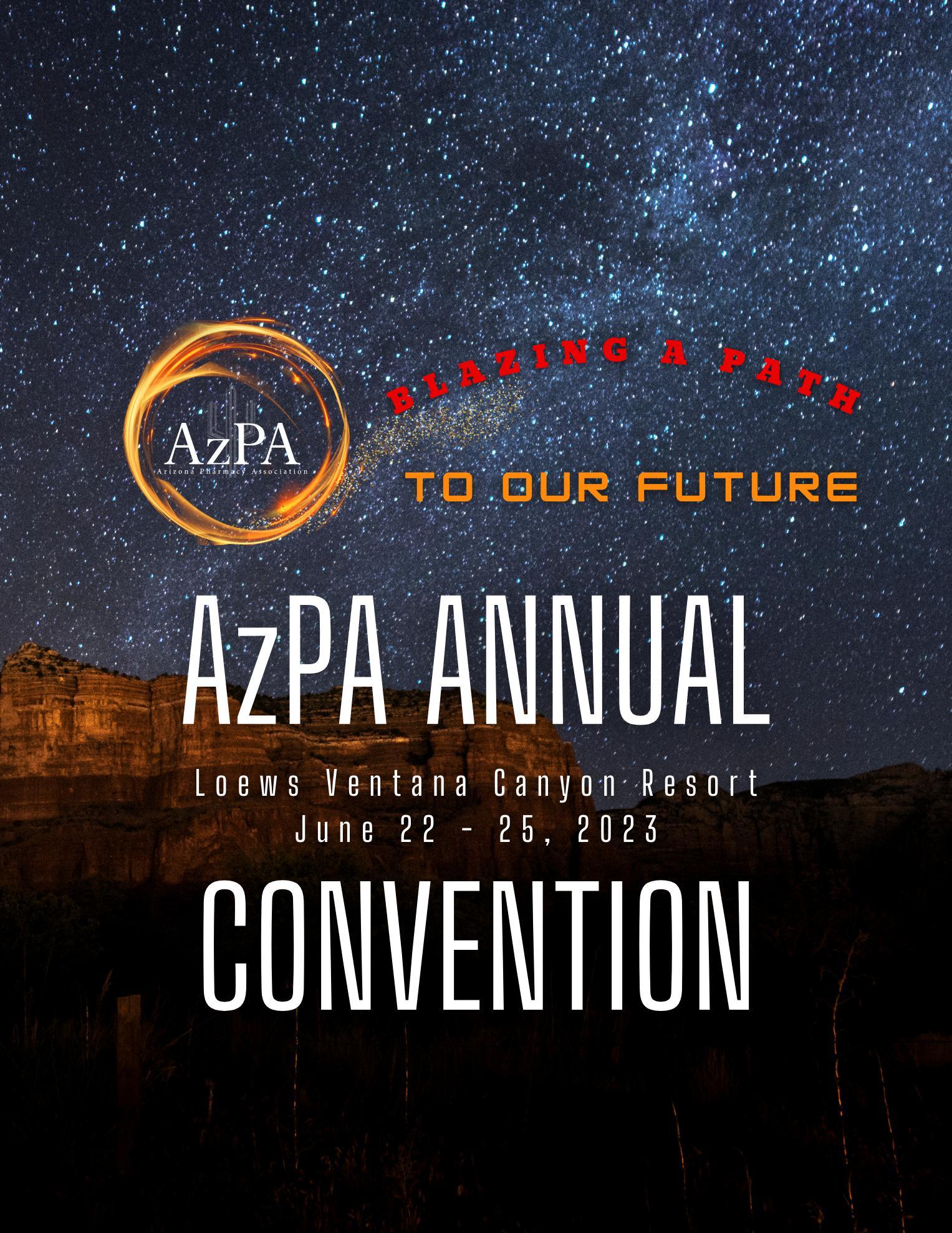

Arizona Journal of Pharmacy O F F I C I A L P U B L I C A T I O N O F A R I Z O N A P H A R M A C Y A S S O C I A T I O N | S P R I N G 2 0 2 3 The Long Haul: A Descriptive Timeline of Long COVID Rx & the Law: Collaborative Practice Agreements and Statewide Protocols In This Edition:
BoardofDirectors2022-2023
OFFICERS
PresidentDawnGerber
PresidentElectKimberlyLangley
PastPresidentDarrenClonts
TreasurerJacobSchwarz
SecretaryNancyCostlow
Director/CEOKellyFine
DIRECTORSATLARGE
CommunityPhillipIeng
HealthSystemChristopherEdwards
TechnicianMelindaBrowning
ReasolChino
RyanGries
BrandyDeChellis
MistyBrannon
NinaVadiei
LIASIONS
UniversityofArizona
StudentChapterJoseEspinoza
Dean'sDesignatedRepresentativeNancyAlvarez
MidwesternUniversity
StudentChapterLyndyAbdelsayed
Dean'sDesignatedRepresentativeMichaelDietrich
CreightonUniversity
StudentChapterSharonRuditser
Dean'sDesignatedRepresentativeJaneStein
LegalCounsel
RogerMorris
ChiefExecutiveOfficer
KellyFine
Education&ProfessionalDevelopment
DawnGerber
Events&StrategicPartnerships
CindyEsquer
Membership&VolunteerServices
Vacant
AdministrativeServices
MelinaEsquer
Editor KellyFine
CreativeCoordinator
ElizabethNelson
TheinteractivedigitalversionoftheArizonaJournalofPharmacyisavailableformembers onlyonlineinyourmemberportal
(480)838-3385|admin@azpharmacy.org
Editor'sNote:Anypersonalopinionsexpressedinthismagazinearenotnecessarilythose heldbytheArizonaPharmacyAssociation."ArizonaJournalofPharmacy"(ISSN1949-0941) ispublishedquarterlybytheArizonaPharmacyAssociationat:1845E.SouthernAvenue, Tempe,AZ85282-5831


President’s Message 4 AzPA News Welcome New Members 6 Az-ASHP State Affiliate News 10 University & Alumni News 28 Editorial Preceptors Corner 11 Arizona State Fact Sheet 16 Rx & the Law: Collaborative Practice Agreements and Statewide Protocols 26 Discount/Cash Cards are Disruptors in the Industry 32 Advocacy AzPA Legislative Update 34 Pharmacy Day at the Capitol 37 Arizona Board of Pharmacy Update 39 Continuing Education The Long Haul: A Descriptive Timeline of Long COVID 18 Contents COVER STORY
pg. 7
AzPAStaff
U P C O M I N G E V E N T S
April22,2023
Glendale,AZ
August26,2023
Virtual

September22,2023
Glendale,AZ
June15,2023
Glendale,AZ
June22,2023
Tucson,AZ
June22,2023
Tucson,AZ
June22-25,2023



Tucson,AZ

3
PRESIDENT'S MESSAGE
Dear AzPA Members,
While attending the February 2023 AzPA Happy Hour, I interacted with a friend and he said, “Have you have you heard about ChatGPT?” I had not, so I replied, “Tell me more ”
That evening while we were driving home from the event, my brain was spinning from everything I had learned about this new technology “ChatGPT is an AIpowered chatbot developed by OpenAI, based on the GPT (Generative Pretrained Transformer) language model. It uses deep learning techniques to generate humanlike responses to text inputs in a conversational manner.” (Brown R. "All you need to know about ChatGPT, the A.I. chatbot that’s got the world talking and tech giants clashing " Published Feb 8, 2023 https://www cnbc com/2023/02/08/what-ischatgpt-viral-ai-chatbot-at-heart-of-microsoft-google-�ght html Accessed March 29, 2023 )
Dawn Gerber, PharmD, BCGP, FASCP, FAzPA Associate Professor of Pharmacy Practice at Midwestern University College of Pharmacy-Glendale, Arizona, earned her Doctor of Pharmacy degree from Drake University, Des Moines, Iowa She completed a pharmacy practice residency at the Creighton University Medical Center, Omaha, Nebraska. Dr. Gerber is a Board Certi�ed Geriatric Pharmacist (BCGP) and recognized as Fellow of the American Society of Consultant Pharmacists (ASCP) and Fellow of the Arizona Pharmacy Association (AzPA). She collaborates with the Banner Geriatric Medical Fellowship Multidisciplinary Rounds She teaches geriatric pharmacotherapy topics and the required Complementary and Alternative Medicine course She has held leadership positions with AzPA, ASCP, and American Society of Health-System Pharmacists (ASHP) She is a Pharmacy Residency Accreditation Practitioner Surveyor with ASHP
I usually embrace technology with gusto I appreciate how technology makes data collection and project collaboration more e�cient and e�ective, just ask my coworkers about my love of Microsoft Forms. But technology is not always the most appropriate mode for certain activities. Email was amazing back in the 1990s and now we are all drowning in email because it has become the default form of communication for everything “Stop Does That Message Really Need to Be an Email?” by Colin D Ellis published in the March 30, 2021 edition of the Harvard Business Review states “[w]hen it comes to communication many approaches are required to ensure that di�erent people, with di�erent interests understand a message clearly and know what action if any needs to be taken in response ” There’s a great �owchart in “Do You Really Need to Hold That Meeting?” by Elizabeth Grace Saunders from the March 20, 2015, edition of Harvard Business Review journal that reviews when something should be a meeting, an email, or phone call and it’s crazy that we live in a world where Harvard Business Review needs to publish an algorithm to determine what communication method should be used
Circling back to the ChatGPT discussion in February 2023 Ever the Learner (Rath, Tom StrengthsFinder 2 0 New York, NY: Gallup Press, 2007 ), I did a quick dive into what ChatGPT might lead to There are articles about undergraduates using ChatGPT to write their research papers and essays. Faculty members using ChatGPT to “help students develop their critical thinking skills by asking them to compare AI-produced content with reliable, valid sources of information.”
(Mucharraz y Cano V, Venuti F, and Martinez RH. “ChatGPT and AI Text Generators: Should Academia Adapt or Resist?” https://hbsp harvard edu/inspiringminds/chatgpt-and-ai-text-generators-should-academia-adapt-or-resist Accessed February 22, 2023 ) There was even some discussion about ChatGPT replacing knowledge workers
This got me thinking a lot about the pharmacy profession. We are known for being highly knowledgeable about medications. We know facts about medications, but so does ChatGPT. If all we are known for is being a walking Micromedex (IBM Micromedex Solutions. Truven Health Analytics, Inc. Ann Arbor, MI.

http://www micromedexsolutions com), we will be replaced by ChatGPT and similar technology
Continued on next page
EDITORIAL
4
CONT. PRESIDENT'S MESSAGE
But pharmacy professionals are so much more than a walking drug reference, textbook, or guideline; we bring that human aspect to the drug facts. We have the capability of connecting with our patients and teammates and tailoring that drug information to that speci�c patient or situation and that is just something that ChatGPT and technology can’t replace. So, I encourage you to bring the same outlook to your professional and personal lives Instead of sending an email, pick up the phone and bring that human element to your interactions with your patients, colleagues, family, and friends

Let the Arizona Pharmacy Association bring a human element to your career. Please join me at the Arizona Pharmacy Association Annual Convention, June 22-25, 2023, in Tucson, Arizona
Sincerely,
Dawn Gerber, PharmD, BCGP, FASCP, FAzPA AzPA President 2022-2023
5
1stYearPractitioner
Darrick Cutway
Elizabeth Ehrichs
Nicholas Smith
2ndYearPractitioner
Rhiannon Garcia
Melvina Lake
Shana Shriber
Pharmacist
Je� Betcher
Kathleen Blomquist
Michael Burkhart
Jun Ho Choi
Kanghee Derocher
Michelle Abou-Eid
Heather Freml
Tosan I. Isemede
Angela Jacobsen
MacKenzie Johnson
Adrijana Kekic
Anna Kit
Brandon Anthony Koolick
Stephanie Lee
Sarah Paslidis
Joseph Pellerito
Amy Quach
Valerie Bostel Richards
Seth Root
Alisha Sellers
Mary Senatore
Melissa Shreve
Bronwyn Simone Smith
Jacqueline Takacs
Karen Vickers
WELCOME NEW MEMBERS!
PremiumPharmacist
John Cao
Mark DiGiacomo
Hovhannes Hakobyan
John Kohli
Ti�any Lee
Erica No�ke
Courtney Weiser
Resident
Caroline Adrian
Andrea Aguayo
Samantha Bodan
James Epley
Gabriella Gambadoro
Sidra Pervez
StudentPharmacist
Aqsa Alvi
Geneveive Baroy
Ana Maria Castro
Samantha Flenning
Gabrielle Gutierrez
Darlene Hall
Derek Hancock
Andrew Hayden
Jacob Mitchell
Olukemi Oshilaja
Alexandra Paden
Misk Al Qaderi
Micaela Solis
Rana Yousef
Retired
James (Mike) Nelson
Associate
Technician
Kimberly Canas
James Candelaria
Sarah Kelland
Edwin Lozada
Bedri Moahmed
Kristine Smith
Kathleen Wynters
Mary A. Candelaria
Derek Hersha
AZPA NEWS 6
COVER STORY ANNUAL CONVENTION
THURSDAY, JUNE 22
8:00am - 5:00pm MOTIVATIONAL INTERVIEWING CERTIFICATE PROGRAM
Separate Registration and Fee
CAPT Chandima Deegala, PharmD, BCPS
8:00am - 5:00pm APHA'S THE PHARMACIST & PATIENTCENTERED DIABETES CARE CERTIFICATE PROGRAM
Separate Registration and Fee

CDR Kimberly Langley, PharmD, MBA, BCPS; Mary Jo Zunic, PharmD, MHA, PhC, BC-ADM, BCACP, CDCES; Tony Albert, PharmD, BC-ADM, BCACP
5:30pm - 7:00pm AZPA BOARD OF DIRECTORS MEETING

Open to all attendees
7:30pm - 8:30pm VIP RECEPTION
Invitation Only
FRIDAY, JUNE 23
Mississippi Mud vs. Modern Marvels for MRSA
Andrew Vogler, PharmD; Scott Volker, PharmD
Buying and Selling a Pharmacy
Sean Du�y, RPh
9:10am - 10:10am BREAKOUT SESSIONS
Remote Work Expectations for Yourself and Others

Juan Kingsbury, TTI Certi�ed Behavioral Analyst
Primary Care Practice Integration for Pharmacist
Stephanie Bellows, PharmD, BCACP, CDCES
10:20am - 11:20am BREAKOUT SESSIONS
Part 1: Implementation of a Pharmacist Managed Birth Control Clinic
Thalia Vega, PharmD, BCACP, LCDR, USPHS; Kelly Fine, RPh, FAzPA
Top 10 New Drug Update
Bob Lipsy, PharmD, BCACP, FASHP, FAzPA
A Dashboard Success Story: The Value of Data to Promote Formulary Compliance
Janelle Duran, PharmD, BCPS; Mike Mesdaghi, PharmD, MBA
11:30am - 12:30pm NON-ACCREDITED LUNCH SYMPOSIUM
12:40pm - 1:40pm BREAKOUT SESSIONS
Biostats 101: A Quick Review for the Board Exams and Improving Patient Care
Jacob Schwarz, PharmD, MBA, BCIDP, BCCCP, BCPS
The Most Accessible Clinician: The Role of Pharmacists in Value-Based Care
Allison Hill, PharmD, RPh
Lessons Learned in the Dominican Republic: A Focus on Interprofessional Education and Pharmacist Wellbeing
Jane Stein, PharmD
1:50pm - 2:50pm
GENERAL SESSION
Generations of Pharmacy
Jimmy Stevens, PharmD; Reasol Chino, PharmD, BCACP, CPH; Yanick Hicks, PharmD
3:00pm - 4:00pm
GENERAL SESSION
Opioid CPE - The Highs and Lows of Addiction
Daniel DeGarmo, PharmD
4:10pm - 5:10pm BREAKOUT SESSIONS
Part 2: Implementation of a Pharmacist Managed Birth Control Clinic
Erin Raney, PharmD, BCPS, BC-ADM
Addressing Chronic Disease with Lifestyle Medicine and Roles for Pharmacists
Edward Stein, PharmD
Preceptor Workshop: A Recipe For Easy Precepting
Suzanne Larson, PharmD; Janet Cooley, PharmD, BCPS; Nicole Henry, PharmD
5:15pm - 7:00pm EXHIBIT HALL: WELCOME RECEPTION Support our Convention Sponsors and Exhibitors while you mingle and enjoy appetizers
7
7:00pm - 8:00pm FRIENDS & ALUMNI MIDWESTERN UNIVERSITY RECEPTION
8:00pm - 10:00pm CASINO NIGHT
Come one, come all and support our Student Academies for a night of family friendly games and networking!
SATURDAY, JUNE 24
7:00am - 7:45am NON-ACCREDITED BREAKFAST SYMPOSIUM
7:00am - 5:00pm STUDENT LEADERSHIP & LEGACY TRACK
Refer to next page
7:00am - 5:00pm TECHNICIAN TRACK
Refer to next page
7:00am - 8:00am 1ST TIME ATTENDEE WELCOME & ORIENTATION
8:15am - 9:45am BREAKOUT SESSIONS
Healing from the Trauma of the COVID Pandemic
Jocelyn Hamsher, Licensed Professional Counselor, LPC, CSAT
Immunization Update
Holly Van Lew, PharmD, BCPS, AAHIVP; Andrew DeMotto, PharmD, BCPS, NCPS
9:55am - 10:55am BREAKOUT SESSIONS
Focus on HIV Treatment: New Medication Review
Kimberly Tran, PharmD, AAHIVP; Jenna Keister, PharmD, PGY1 Resident; Lawrence York, PharmD, BCIDP, BCPS, AAHIVP
Focus on Diabetes: Diabetes Technology: A Focused Update on New Continuous Glucose Monitors and Introduction to Insulin Pump Options
Jacob Northrup, PharmD, BC-ADM, CDCES; Lisa Beckett, PharmD, BCACP, CDCES
Part 1: Smile! Fluoride Varnishes, Pharmacists' Next Community Healthcare Service
Lisa Tonrey, MHA, BPharm, PhC, FAPhA, FLDI, CAPT, USPHS (retired); Scott Hamstra, MD, USPHS (retired); Kelly Fine, RPh, FAzPA
11:05am - 12:05pm BREAKOUT SESSIONS
Focus on HIV Treatment: Guideline Update
Kimberly Tran, PharmD, AAHIVP; Jenna Keister, PharmD, PGY1 Resident; Lawrence York, PharmD, BCIDP, BCPS, AAHIVP
Focus on Diabetes: The Modern Epidemic: Important Updates to ADA 2023 and AACE 2022 Guidelines for Treatment of Type 2 Diabetes Mellitus
Jacob Northrup, PharmD, BC-ADM, CDCES; Courtney Coombe, PharmD, CDCES
Part 2: Smile! Fluoride Varnishes, Pharmacists' Next Community Healthcare Service
Lisa Tonrey, MHA, BPharm, PhC, FAPhA, FLDI, CAPT, USPHS (retired); Scott Hamstra, MD, USPHS (retired)
12:15pm - 2:00pm EXHIBIT HALL | LUNCH
Support our Convention Sponsors and Exhibitors while you mingle and enjoy lunch
2:10pm - 3:30pm KEYNOTE GENERAL SESSION
Russ Hill

3:45pm - 4:45pm BREAKOUT SESSIONS
Focus on HIV Treatment: Case Discussions
Pamela Allison, PharmD; ; Zachary Lancaster, PharmD, BCACP, AAHIVP
Focus on Diabetes: Win Win Improve DM Care and Bill for Services
Nicole Scovis, PharmD, BCPS, BCACP
Medication Error: I Didn't Do That
Eman Kirolos, PharmD, RPh, MS, DASPL
5:00pm - 5:45pm PAST PRESIDENT’s RECEPTION Invitation Only
5:00pm - 5:45pm VOLUNTEER COMMITTEE GATHERING Invitation Only
5:30pm - 6:30pm FRIENDS & ALUMNI UNIVERSITY OF ARIZONA RECEPTION
7:00pm - 9:00pm BLACK TIE OPTIONAL AWARDS PRESENTATION
Join us for a celebration of AzPA’s prestigious 2023 awardees. This evening is a not-to-be-missed event! Attendees will be dressed to impress!
SUNDAY, JUNE 25
7:00am - 8:00am GENERAL SESSION/BREAKFAST
Heading Towards Our Future: AzPA Town Hall
Darren Clonts, PharmD, MBA, BCACP; CDR Kimberly Langley, PharmD, MBA, BCPS; Dawn Gerber, PharmD, BCGP, FASCP, FAzPA; Kelly Fine, RPh, FAzPA
8:00am - 12:00pm Drug Discovery Workshop (Non-CE) Separate Registration Required (No-Charge event)
Sponsored by P�zer
Lindsay Davis, PharmD; Kevin Stigge, MD
8:10am - 9:10am BREAKOUT SESSIONS
Focus on HIV Treatment: Debate
Timothy Ivers, PharmD; Yousef Toma, PharmD, CSP, AAHIVP
Regulatory Overview TBD
Focus on HIV Prevention: Pre-Exposure Prophylaxis (PrEP) for the General Practitioner
Lawrence York, PharmD, BCIDP, BCPS, AAHIVP; Alyssa Campbell, CPhT
9:20am - 10:40am GENERAL SESSION
2023 Pharmacy Law Update
Roger Morris, RPh, JD; Katie Lavigne, JD; Kaitlyn Fydenkevez, JD
R E G I S T R AT I O N O P E N N O W ! Learn More at: a z p h a r m a c y o r g / 2 0 2 3 c o n v e n t i o n
8
10:50am - 11:50am BREAKOUT SESSIONS
Breast Cancer Pharmacogenomics
Jeremy Gerber, PharmD, MBA, BCPS, BCOP, CNSC
How to be a R.E.A.L Success Yanick Hicks, PharmD
Focus on HIV Prevention: Post-Exposure Prophylaxis (PEP) 101
Kristen Ellis, PharmD, BCPS, AAHIVP; Alyssa Campbell, CPhT
12:00pm - 1:00pm NON-ACCREDITED LUNCH SYMPOSIUM
SATURDAY, JUNE 24 SEPARATE TRACKS
TECHNICIAN TRACK
Note: Technicians have an opportunity to attend any other CE session accredited for technicians (UAN ends in T)
7:00am - 7:45am NON-ACCREDITED BREAKFAST SYMPOSIUM
7:00am - 8:00am 1ST TIME ATTENDEE WELCOME & ORIENTATION
8:00am - 9:00am Beyond the Pharmacy Counter
Kristen Snair, MSJ, CPhT
9:05am - 9:35am Patient Safety Clinical Pearls for Technicians
Melinda Browning, MSc, CPhT, FAPC
9:40am - 10:10am Interview Tips and Tricks for Technicians
Jeremy Gerber, PharmD, MBA, BCPS, BCOP, CNSC
10:15am - 11:15am PTCB-Advanced Technician
Certi�cations
Ryan Burke, PharmD
11:20am - 12:20pm USP 797/800 Update
Nick Ruiz, CPhT
12:15pm - 2:00pm EXHIBIT HALL | LUNCH
Support our Convention Sponsors and Exhibitors while you mingle and enjoy lunch
2:10pm - 3:30pm KEYNOTE GENERAL SESSION
Russ Hill

3:30pm - 5:00pm Mock Interviews
Valerie Richards, PharmD
STUDENT TRACK
7:00am - 7:45am NON-ACCREDITED BREAKFAST SYMPOSIUM
7:00am - 8:00am First Time Attendee Welcome & Orientation
8:00am - 9:00am What Can One Do with a PharmD? Hint: It's More than Put Pills in a Bottle!
Casey Orton, PharmD
9:10am - 10:10am Post-Grad Life: 1 Year, 5 Years, 10 Years, 30 Years and Beyond

Fizza Saeed, PharmD; Valerie Richards, PharmD; Andrew Gildon, PharmD
10:15am - 11:15am Leveraging Social Media to Your
Professional Advantage
Jacob Schwarz, PharmD, MBA, BCIDP, BCCCP, BCPS, FAzPA; Christi Jen, PharmD, BCPS, FASHP, FAzPA
11:20am - 12:20pm How to Network
CDR Kimberly Langley, PharmD, MBA, BCPS
12:15pm - 2:00pm EXHIBIT HALL | LUNCH
Support our Convention Sponsors and Exhibitors while you mingle and enjoy lunch.
2:10pm - 3:20pm Interview Tips and Tricks for Students
Dawn Gerber PharmD, BCGP, FASCP, FAzPA; Jessica DiLeo, PharmD, BCGP, BCACP, CMWA, FAzPA; Amy K Kennedy, PharmD, BCACP
3:30 Valer
Loews Ventana Canyon Resort
R E G I S T R AT I O N O P E N N O W ! Learn More at: a z p h a r m a c y o r g / 2 0 2 3 c o n v e n t i o n
7000 North Resort Drive | Tucson, AZ
BOOK YOUR HOTEL ROOM
BOOK YOUR ROOM
9
AzPA HEALTH SYSTEM SPECIAL INTEREST GROUP (AZ-ASHP)




Spring is in the air and so far, aside from some concerning drug shortages, this year is o� to a great start!
We had a very successful Spring Clinical Meeting recently where AzPA introduced “Focused Tracks.” These tracks were designed to be a deep dive on a speci�c topic relevant to pharmacy practice At Spring Clinical, the tracks were hyperlipidemia and sepsis
Overall, the feedback was very positive! If you were in attendance, please be sure to let us know how you felt. Focused Tracks will be back in June during AzPA’s Annual Convention! I look forward to seeing you there!

Join Us!
As a reminder, the Health Systems Pharmacy SIG is actively recruiting new members. If you are interested in getting involved, please sign up using the link below We meet monthly to discuss issues relevant to health systems pharmacists in Arizona The more perspectives we have on this group, the more we can make sure AzPA is serving the needs of its health systems members. Hope to see you on the next call!
Learn More Here
All the best,
Christopher J. Edwards, PharmD, BCPS, FASHP , FAzPA AzPABoardofDirectors-HealthSystem
Christopher J. Edwards, PharmD, BCPS, FASHP,FAzPA AzPA Board of Directors-Health System
AZ-ASHP AFFILIATE NEWS 10
"Inthewinterpublicationofthe ArizonaJournalofPharmacy, MichaelPhamdiscussedhis thoughtsabouthisupcoming IntroductoryPharmacyPractice Experiences.Hisreflectionhelped orientpharmacistsandpreceptors tothefearandapprehensionof firstyearpharmacystudents preparingtoembarkontheirfirst professionalexperiences.Asa counterpoint,thisarticleis writtenbyAPPEstudentDesiree Greenberg,reflectingonthe impactofherIPPErotationsupon herprofessionaljourney.Together , bothofthesearticlesaremeant toinspirecurrentandfutureIPPE preceptorsabouttheimpactthey canhaveuponstudent pharmacistsearlyintheir journeys."
The Impact of Introductory Pharmacy Practice Experiences: A Reflection on My Journey

AUTHORS/CONTRIBUTORS
SuzanneLarson,PharmD,DirectorofExperientialEducation, MidwesternUniversityCollegeofPharmacy
JanetCooley,PharmD,BCACP , Associate Professor, DirectorofExperientialEducation, UniversityofArizonaCollegeofPharmacy
DesireeGreenberg,PharmDCandidate,Classof2023 MidwesternUniversityCollegeofPharmacy
DISCLOSURE
Theauthor(s)declarenorealorpotentialconflictsorfinancialinterestinanyproduct orservicementionedinthemanuscript,includinggrants,equipment,medications, employment,gifts,andhonorarium.
FUNDING
Thisresearchwasnotfunded.
JanetCooley&SuzanneLarson
EDITORIAL PRECEPTOR CORNER 11
As a current APPE student, I can con�dently say that I look back on my Introductory Pharmacy Practice experiences (IPPEs) as a pivotal time in my journey in becoming a pharmacist Both IPPE and APPE rotations are an important element of pharmacy school and represent an opportunity to experience pharmacy practice and demonstrate that we can be successful in a professional pharmacy setting As �rst year students, the �rst step that we take towards preparing for IPPE rotations is to prepare and submit our list of IPPE site preferences, which was a nerve-wracking prospect These are the sites where we will be getting our �rst pharmacy experiences outside of the classroom and we want to be paired with sites and preceptors that will give us the best experience possible. As students, we are told when choosing sites to take into consideration location and site descriptions, but to keep an open mind in case we are not placed with the sites we requested. I spent hours determining which sites and preceptors best aligned with my goals and professional needs for IPPEs, and I submitted my list feeling con�dent and excited about my choices and the experiences that awaited me. The week after our winter break is when our site assignments become visible, and I remember spending my entire break anticipating my rotation assignments When the assignments were posted and I opened the website to see them, the results were not what I had hoped for. For my community site, I had received one of the lowest choices on my list and for my institutional site, I had received a site that I had not even considered This institutional site was in an unfamiliar part of downtown Phoenix and the site description was intimidating and did not sound like this site would be conducive to my style of learning Feeling in need of some guidance, I made an appointment with the director of O�ce of Experiential Education (OEE) to express my concerns and to see if she had any guidance for me. I think one of the most important pieces of advice that I got from the director is that the point of IPPEs is to help us, as students, get familiar with the �ow of the pharmacy and get our feet wet. We aren’t expected to be able to jump right in and know everything right away, we are just expected to put forward our best e�ort and try to learn as much as we can in the short time that we’ll have at each site. I left that meeting with a renewed sense of con�dence in myself and accepted that, although the outcome hadn’t been what I had hoped for, I needed to give these sites and preceptors a fair chance - just like I hoped that they would give me a fair chance.
As the last quarter of my �rst year of pharmacy school came to an end, the start of my IPPE rotations grew closer Although I had long since come to terms with the sites that I was assigned, I still had a lot of di�erent thoughts and emotions as I was preparing to start my IPPEs I was simultaneously hesitant and excited for what was to come, and I had no idea what to expect. Having had no previous experience in the �eld other than what I had earned from my �rst-year classroom courses, I felt unsure of myself and in my ability to excel in a real-world pharmacy setting I understood that our �rst-year coursework had given me the fundamental knowledge that I needed, but I didn’t know how else to prepare myself for what was to come I had so many questions Would my preceptors be kind and patient with me? Would I be welcomed into these
sites as part of the team, or would I feel like I didn’t belong? Would they understand my insecurities and work with me to grow in the profession? Would I be able to live up to expectations and earn a good review from my preceptor? And most importantly, would I get everything out of the experience that I wanted to in order to further myself in my pharmacy career? As the �rst day of my rotations approached, I was determined to brush these uncertainties aside and keep a positive attitude. I had one major goal as my focus for my rotations - to build a strong relationship with my preceptor and make a positive and lasting impression on them
I started the �rst day of IPPE rotations at the institutional site, and I was so nervous and scared because I really wanted to make a great �rst impression When I �rst met my preceptor, I remember feeling so in awe of her; she was nice and welcoming, and she was so impressive that it was almost intimidating. After having the chance to talk with her for a while and getting introduced to everyone else on the pharmacy team, I felt much more at ease because all of the preconceptions that I had built up in my mind were replaced by what I was really experiencing Although I had initially wanted nothing more than to switch to a di�erent site for this rotation, it didn’t take long before I was feeling lucky and grateful for having been assigned to this site and this preceptor. Throughout my entire rotation there, there were so many aspects of the site and the rotation that made it a positive and memorable experience My preceptor was consistently reassuring and understanding which really helped me to open up and feel comfortable to ask questions and o�er my opinions on topics She also made sure to give me the chance to work with other preceptors and other healthcare professionals within the hospital which provided the opportunity to learn something from many di�erent professionals My days never felt repetitive or stagnant I felt very grateful to have the opportunity to gain some �rst-hand insight into the unique perspectives of each person that I worked with, especially at such an early stage in my career
One of the best things for me to come out of my time at this site was that my preceptor and some of my other colleagues gave me my �rst introduction to pharmacy residency Up to that point I had only heard of residency in passing, but once they started talking to me about it, I was able to ask each person about their experiences with residency Their responses and insights were eye opening and began my interest in pursuing residency By the end of the rotation, I was comfortable at the site and was thoroughly enjoying my time there. I was sad to see this experience ending. I had accomplished my goal of building a strong relationship with my preceptor and becoming a part of the pharmacy team I was able to get clinical experience and learn about the profession of pharmacy as a whole. This was the �rst time since the start of my pharmacy career that I was really able to see �rst-hand how much pharmacists can do and the ways that we can contribute to the functions of the hospital. This was inspiring and helped propel me forward, which was really inspiring Moving on to my second rotation, I felt more con�dent and ready for the new challenges that I would face.
CONT. PRECEPTOR CORNER 12
As I started my second IPPE rotation at a community pharmacy site, I could tell right from the start that this would be signi�cantly di�erent from my �rst rotation This made me nervous yet excited because I would have the opportunity to continue to learn new things. My preceptor at this site was very welcoming from the beginning and I could tell that she had high hopes and expectations of me. I wanted to do everything that I could to live up to those expectations. At the beginning of the rotation, I was assigned to work closely with the pharmacy technicians helping them with their work in order to get better acquainted with the pharmacy work�ow Working with the technicians was insightful. I don’t know if I had fully appreciated their role in pharmacy operations prior to this I also received the opportunity to work directly with patients face-to-face and on the phone This is where my passion for patient interaction started to blossom. Soon enough, I was moved past technician work and was able to work more closely with my preceptor This was important because she gave me an in-depth look at all aspects of her job and what it takes to run a successful community pharmacy. One characteristic of my preceptor that I appreciated was that she put e�ort into challenging me and bringing me out of my comfort zone Her e�orts to challenge me helped to build up my con�dence, but more importantly it showed me a lot about myself and my ability to overcome adversity and keep a level head in stressful situations On top of this, she was a noticeably e�cient and e�ective leader and served as a great example for how to successfully lead a team and how to get the most out of your team members Watching the e�ect that she had on her team helped to inspire me to enroll in the optional student leadership development curriculum o�ered at my school. As this rotation wrapped up, I felt that I had grown tremendously. My preceptor had a very positive impact on me
After my IPPEs had concluded and I transitioned back into classroom learning, I felt what I had learned and experienced on IPPE rotations had changed me and would continue to drive me moving forward In my didactic courses, when we would discuss di�erent scenarios, I now had the context that I needed to picture myself in those settings and I was able to imagine why the principles we were learning applied to my future duties as a pharmacist Outside of the classroom, my experiences led me to seek out more leadership roles in student organizations in order to continue to build on the skills that I had learned The amazing experiences that I had with my IPPE preceptors encouraged me to make more of an e�ort to get to know my professors and advisors so that I could learn from them and build more professional relationships
I am currently in my third and �nal professional year and amid my APPEs. Going into APPEs, I was less focused on getting my preferences, because I felt more prepared and con�dent in myself than I had before IPPEs I credit the positive and formative experiences that I had in my IPPEs with this change, as my appreciation that some of the most rewarding experiences come from the unexpected Collectively, my IPPE experiences gave me a foundation to build from and prepared me to handle whatever was to come in my APPEs. Perhaps more importantly, those
experiences gave me a lot of insight into what career paths I gravitated towards I am currently in my third block of APPE rotations and in the midst of preparing my residency applications, and I am grateful for lessons and experiences that I have gained through both classroom and experiential learning because I feel that they have provided the tools needed to be successful in my bid for residency. I still think back on the relationships that I was able to build with my IPPE preceptors and the lessons that they taught me, and I am very appreciative of how supportive and understanding they were of me during my �rst professional pharmacy experiences
We hope that reading Desiree's re�ections of her rotations highlight the great impact that preceptors can have on our most novice learners.
If you’d like to learn more about becoming an IPPE preceptor, reach out to azoee@midwestern.edu or cooley@pharmacy.arizona.edu.
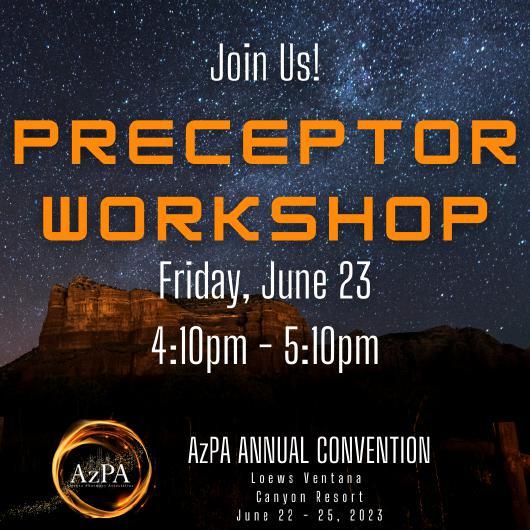
CONT. PRECEPTOR CORNER 13


14

15

16
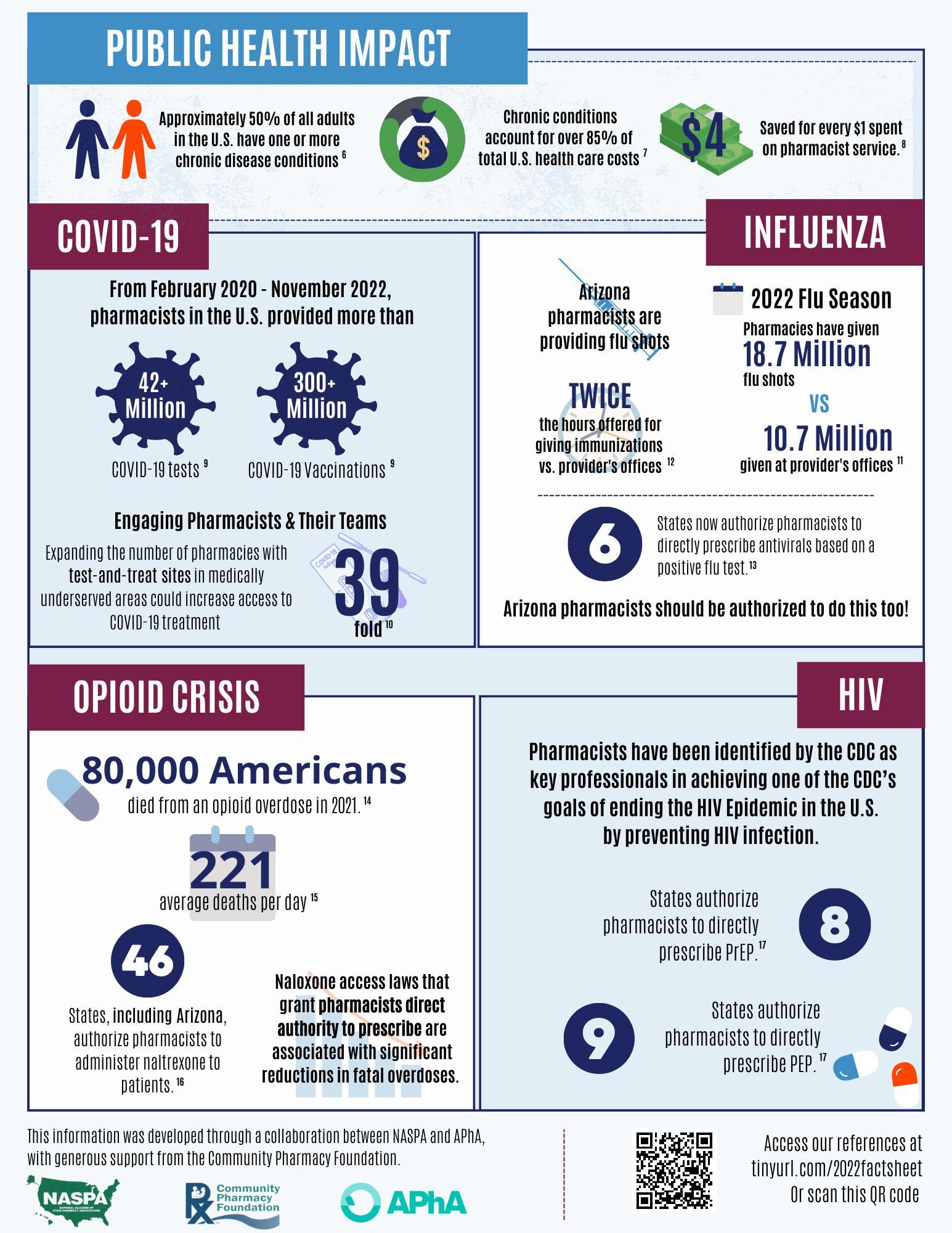
17
"Overthecourseofthe pandemic,moreknowledge wasgainedaboutthevirus, allowinghealthprofessionals todevelopbettertechniquesto treatthoseinfectedand improvesurvivability.While survivalremainedthefocusof thetreatmentapproach,itwas becomingclearthatsurviving COVID-19wouldnotmeanan endtotheeffectsofinfection."
The Long Haul: A Descriptive Timeline of Long COVID
AUTHORS/CONTRIBUTORS
DanielOtis,PharmDCandidate MidwesternUniversityCollegeofPharmacy
DawnKnudsenGerber,PharmD,BCGP,FASCP,FAzPA MidwesternUniversityCollegeofPharmacy
KellyFine,RPh,FAzPA ArizonaPharmacyAssociation
ACKNOWLEDGEMENT- None
FUNDING - Thisresearchwasnotfunded
DISCLOSURES - Theauthorshavenorelevantfinancialrelationshiptodisclose
CONTINUING EDUCATION INFORMATION
Target Audience: Pharmacists, Pharmacy Technicians

Activity Type: Knowledge
Learning Objectives:
1 Define Post-COVID-19 Conditions (PCC).
2 List early factors that predict post-acute COVID-19 sequelae
3 Identify PCC symptoms described by National Institute for Health and Care Excellence (NICE) guideline [NG188].
CONTINUING EDUCATION
18
Background of Long COVID
As the pandemic reached the United States in early 2020, a constant stream of information �ooded the media about the devastating impact of the SARS-CoV-2 virus Though information was �owing, scientists were still struggling to keep up with the world’s growing list of questions. How is the virus spreading? What can the public do to best protect themselves? What symptoms should be expected through infection? How deadly is it? Based on recommendations of health o�cials, the country began to close its doors, as the public was advised to maintain social distancing practices, masking, and isolation while infected, to avoid transmission and save lives. In the �rst days of the COVID-19 pandemic, mortality and infection rates were displayed with live updates for local areas, emphasizing the focus on the most severe results of infection. As the virus spread though communities, distinct di�erences in severity of symptoms began to appear between infected individuals The spectrum ran from asymptomatic patients to those su�ering from severe illness and death In late 2020, the development of a vaccine helped to prevent hospitalization and severe cases of SARS-CoV-2. Over the course of the pandemic, more knowledge was gained about the virus, allowing health professionals to develop better techniques to treat those infected and improve survivability. While survival remained the focus of the treatment approach, it was becoming clear that surviving COVID-19 would not mean an end to the e�ects of infection
In April of 2020, still early in the pandemic, a growing movement began to emerge Patients were claiming they had not fully recovered from the course of their infection, or that they had recurring symptoms they believe to be associated with their initial bout of COVID-19. The majority of patients recover fully from infection, but some saw symptoms linger for weeks or months after their acute phase of the illness had ended. Support groups began to develop in online forums for those believed to be su�ering from “Long COVID,” a term coined by these groups Those still su�ering from symptoms well after the acute phase became known as “Long Haulers ” Via a collaboration with Natalie Lambert, Survivor Corps, and the Indiana University School of Medicine, long haulers’ list of symptoms was compiled for analysis
The �ndings showed that many of the symptoms continued to be those recognized by the CDC (Centers for Disease Control) as part of an acute infection This list includes fatigue, muscle or body aches, shortness of breath or di�culty breathing, headache, cough, fever or chills, and a partial or complete loss of sense of smell. These symptoms were well known at this point in the pandemic and commonly associated with the SARS-CoV-2 virus. However, their survey also revealed a growing list of chronic symptoms being frequently reported by long haulers, that was not accounted for by an acute infection Di�culty concentrating or focusing, inability to exercise, di�culty sleeping, anxiety, and memory problems were some of the notable symptoms that topped the list. Patients expressed a wide range of debilitating symptoms with little or no research at the time to support their claims Perhaps more troubling was that these symptoms were occurring or lasting well beyond the timeframe given
for an acute infection with COVID-19. Many of the long haulers reported di�culty getting the care they needed from medical providers who couldn’t act without the scienti�c evidence supporting their claims
Growing Concern
Researchers began to take interest in this topic and within a short space of time data began to support the anecdotal claims of long COVID. The growing concern eventually reached the White House, where President Biden addressed the public in his “Memorandum on Addressing the Long-Term E�ects of COVID-19” on April 5, 2022 (hyperlink: https://www.whitehouse.gov/brie�ngroom/presidential-actions/2022/04/05/memorandum-onaddressing-the-long-term-e�ects-of-covid-19/) As a part of his address, the president voiced the need for an action plan to research the e�ects of long COVID and support the Americans who continued to su�er from the disease, without answers or relief The National Research Action Plan on Long COVID, or “the Plan” as it would come to be known, would create a nation-wide research agenda with the focus on prevention, diagnosis, treatment, and providing support to those still su�ering from long COVID.
In understanding this new illness, the Centers for Disease Control and Prevention (CDC) worked to de�ne it. In November of 2020, Post-COVID-19 Conditions (PCC) was developed as an umbrella term to refer to long COVID and its many alternate names This would serve to simplify discussion and create uniformity in how health professionals and researchers refer to the condition. The Plan reviewed the various de�nitions of long COVID by multiple health organizations but included its own working de�nition as “Long COVID is broadly de�ned as signs, symptoms, and conditions that continue or develop after initial COVID-19 or SARS-CoV-2 infection The signs, symptoms, and conditions are present four weeks or more after the initial phase of infection; may be multisystemic; and may present with a relapsing–remitting pattern and progression or worsening over time, with the possibility of severe and life-threatening events even months or years after infection Long COVID is not one condition. It represents many potentially overlapping entities, likely with di�erent biological causes and di�erent sets of risk factors and outcomes ”
Although still used interchangeably by the public, PostAcute-Sequelae of SARS-CoV-2 infection (PASC), di�ers from PCC in that it focuses on the direct and indirect consequences of the virus on human health PASC is often the term used in research for scientists working to discover the mechanism of PCC’s pathology.
Di�cult Path Forward
Before diving into the data thus far, it is important to mention the challenges researchers face on the topic of PCC Many of these di�culties stem from the nature of the pandemic itself While COVID-19 a�ects people of all ages, the focus of this article is adult patients SARS-CoV-2 was far reaching and spread fast, giving it a major advantage over scientists tasked to study it. It has been tremendously complicated to accurately assess who has and has not contracted COVID-19
continued on next page
1 2 3 4 5 6 3 9 5 7 8 9 19
CONT. CONTINUING EDUCATION
Throughout the pandemic, the country saw reliability issues and mass shortages of COVID-19 tests. As at home rapid antigen tests became more widely available, the country established a better sense of the number of infected persons. To the test’s criticism, many doubted their results because of the high yield of false positive and false negative results
According to the U.S (United States) Food and Drug Administration (FDA) the antigen tests detect SARS-CoV-2 at least 80% of the time in infected individuals and may need repeated testing to verify results Adjusting expiration dates on products only added fuel to the claims that antigen tests were unreliable. Aside from access and reliability, many individuals chose not to test for the virus and those who were asymptomatic didn’t have cause to test These examples illustrate the struggle researchers face in generating a baseline pool of subjects who have previously con�rmed cases of COVID-19. Even relying on study participants with test-con�rmed COVID-19 would not fully encompass those previously infected with SARSCoV-2.
Additionally, scientists have yet to discover the mechanism of pathology behind PCC and its wide-reaching symptoms Determining how the virus is still impacting the body and by what mechanism it is causing its dysfunction, would allow for diagnostic testing for PCC that circumvents the di�cult history of con�rming a diagnosis of COVID-19 Post-COVID-19 symptoms are displayed in a wide variety of body tissues. Classifying symptoms as having causal relationship to a past infection of SARS-CoV-2 would be near guesswork without a de�nitive way of identifying the pathology The National Research Action Plan on Long COVID addresses these concerns and the need for nationwide research into these areas and since its release, the science community has taken up that call to action
Current Data
The current data surrounding PCC is extensive and as a result of President Biden’s action plan, it continues to rapidly expand In an attempt to compile information in a succinct way, this section has been composed in a question-and-answer format.
Who is likely to get post-COVID-19 Conditions?
Anyone who has previously contracted COVID-19 is at risk for PCC. It has been established that severity of acute COVID-19 is directly linked to an increased risk of having PCC Ziyad Al-Aly et Al’s researched used a U S Department of Veteran A�airs (VA) database Ziyad Al-Aly et. al state, “Our analysis of an array of prespeci�ed outcomes reveals a risk gradient that increases according to the severity of the acute COVID-19 infection (that is, whether patients were not hospitalized, hospitalized or admitted to intensive care).” See Figure 1. Because vaccinations resulted in less severe cases of COVID-19 and hospitalization, this relationship can be extended to vaccinations decreasing the risk of PCC This was addressed in their publication titled “Long COVID After Breakthrough SARS-CoV-2 Infection” which used VA data.
“Compared to people with SARS-CoV-2 infection who were not previously vaccinated (n = 113,474), people with
breakthrough infections (BTI) exhibited lower risks of death (HR = 0 66, 95% CI: 0 58, 0 74) and incident post-acute factors elae (HR = 0 85, 95% CI: 0 82, 0 89) Altogether, the �ndings suggest that vaccination before infection confers only partial protection in the post-acute phase of the disease; hence, reliance on it as a sole mitigation strategy may not optimally reduce long-term health consequences of SARS-CoV-2 infection. The �ndings emphasize the need for continued optimization of strategies for primary prevention of BTI and will guide development of post-acute care pathways for people with BTI.” Those who were vaccinated and su�ered a breakthrough case of COVID-19 are less likely to su�er from PCC While vaccinations decreased the risk of PCC, there is not a single answer in preventing chronic condition.
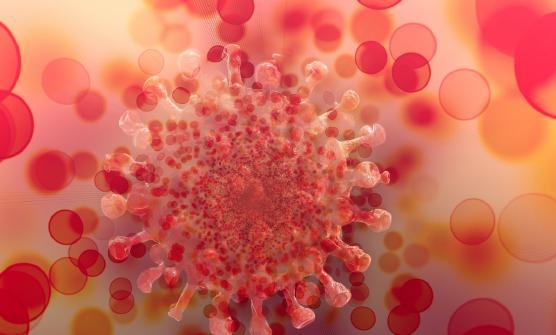
What has been proven to prevent it?
According to the National Research Action Plan on Long COVID, “The best prevention of Long COVID and its related impacts remain to avoid infection and reinfection of SARSCoV-2 by following basic interventions such as getting vaccinated and boosted, maintaining social distancing, wearing a mask, and handwashing At the same time the United Stated Department of Health and Human Services (HHS) will work diligently to advance research to prevent, diagnose, treat, and alleviate the impact of Long COVID for the nation ” The only strategy shown to prevent PCC is avoiding initial COVID-19 infection. Washing hands, wearing a mask, vaccination, and isolation of infected individuals is the current way to safeguard from infection
Who has post-COVID-19 Conditions?
From date reported in the U.S. Census Bureau’s Household Pulse Survey, the CDC suggests the prevalence of PCC is anywhere from 5-30% of the population In a report posted to Morbidity and Mortality Weekly Report (MMRW) Early Release, “Among all patients aged ≥18 years, 38% of case-patients experienced an incident condition compared with 16% of controls; conditions a�ected multiple systems, and included cardiovascular, pulmonary, hematologic, renal, endocrine, gastrointestinal, musculoskeletal, neurologic, and psychiatric signs and symptoms ” These sources support each other’s �ndings and consensus that 1 in 5 adults have had symptoms of PCC.
CONT. CONTINUING
continued on next page 1, 7, 10 7, 10 11 12 5 13, 14 15 20
EDUCATION
CONT. CONTINUING EDUCATION
FIGURE 1
Reference: Al-Aly Z, Xie Y, Bowe B High-dimensional characterization of post-acute sequelae of COVID-19 Fig 3: Risks and burdens of incident prespeci�ed high-resolution post-acute COVID-19 outcomes Nature 2021;594(7862):259-264

21
CONT. CONTINUING EDUCATION
What are the symptoms of PCC?
The symptoms of PCC have been far-reaching and vary from person to person Using data provided by the National Institute for Health and Care Excellence (NICE) guideline [NG188], this chart serves to illustrate some of the most common symptoms reported across various body systems
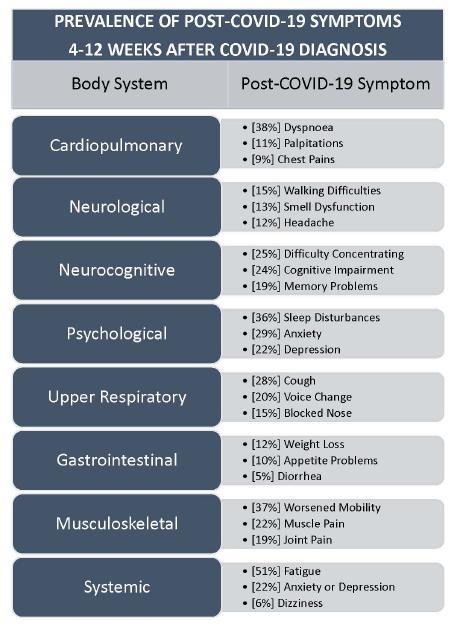
Until we have a better idea of the mechanism of the pathology, we cannot target the actual cause of the symptoms The current approach by primary care physicians is to manage patient symptoms This is being done through both pharmacological and nonpharmacological methods. Patients are recommended to keep a journal of their symptoms and record activities that aggravate the condition and those that provide some form of relief. This will serve to better facilitate symptom management for the primary health provider and empower the patient with ways to manage their symptoms without the need for an o�ce visit
What is understood about the cause of post-COVID-19
Conditions?
SARS-CoV-2 virus is not unique in developing into a chronic condition. Many acute viral infections carry this potential, an example of this being Ebola virus. Following an Ebola outbreak from 2013-2016, researchers found that those su�ering from Ebola Virus Disease (EBV) were still showing symptoms of a post-Ebola syndrome > 2 5 years later. Recognizing similar disease states provides useful insight into the pathology of PCC. Post-COVID-19 Conditions closely resemble many of the same symptomology of myalgic encephalomyelitis/chronic fatigue syndrome (ME/CFS). Both diseases display a range of chronic fatigue, muscle pain, and malaise, with potential viral involvement These examples are beginning to shine light on potential mechanisms for pathology
How long do post-COVID-19 symptoms last?
Currently, the anticipated duration of post-COVID-19 symptoms is unclear. Some patients see relief of symptoms after weeks or months, but the research is ongoing This is made more di�cult by the relapsing and remitting pattern of symptoms being experienced by those su�ering from the disease.
Do any potential treatment options exist?
In a systematic review of current data exploring treatment options, the authors give their expert opinion, “Despite the many guidelines available to date, there are no established treatments of long-COVID Pharmacological research is studying known drugs that act on the reduction or modulation of systemic in�ammation, or innovative drugs used in similar pathologies
Rehabilitation now seems to be the safest treatment to o�er, whereas we will have to wait for the pharmacological research trials in progress as well as plan new trials based on a better understanding of the pathogenic mechanisms ”
The British Immunological Society’s report “Long-term Immunological Health Consequences of COVID-19” discusses how the human body’s innate response to viral infection is likely a contributing factor in the development of post-COVID-19 Conditions. “While COVID-19 was initially considered a respiratory syndrome, it is now clear that damaging �brosis* (scarring) and in�ammation can be found in multiple organs including lung, heart, kidneys, liver, adrenal glands, and gastrointestinal tract, although these phenomena vary widely between individuals The extent of disease partly re�ects the wide distribution of the cellular receptor for SARS-CoV-2, angiotensinconverting enzyme 2 (ACE-2*), but also the indirect e�ects of in�ammatory mediators.” Viral receptors spread across many tissue types, combined with an exaggerated immune response has likely contributed to the wide distribution of virus and the array of chronic symptoms being experienced by su�erers of PCC. The British Immunological society continues, “In general, in�ammation may worsen pre-existing conditions, but equally may cause them. Some secondary illnesses may persist for years, such as in�ammation-induced cognitive decline, psychosis, mood disorder and fatigue ”
In a longitudinal investigation, “Multiple early factors anticipate post-acute COVID-19 sequelae,” the authors were able to identify risk factors of those likely to experience PASC See Figure 2 Through extensive bloodwork of participants followed from initial diagnosis of COVID-19 and then again 2-3 months later, the authors were able to identify four commonalities in those with PASC “We resolved four PASC-anticipating risk factors at
TABLE 1
continued on next page 16 17 18 19 19 22
According to COVID-19 rapid guideline: managing the longterm e�ects of COVID-19 (NICE guideline NG188)
CONT.
CONTINUING EDUCATION
the time of initial COVID-19 diagnosis: type 2 diabetes, SARS-CoV-2 RNAemia, Epstein-Barr virus viremia, and speci�c autoantibodies ”
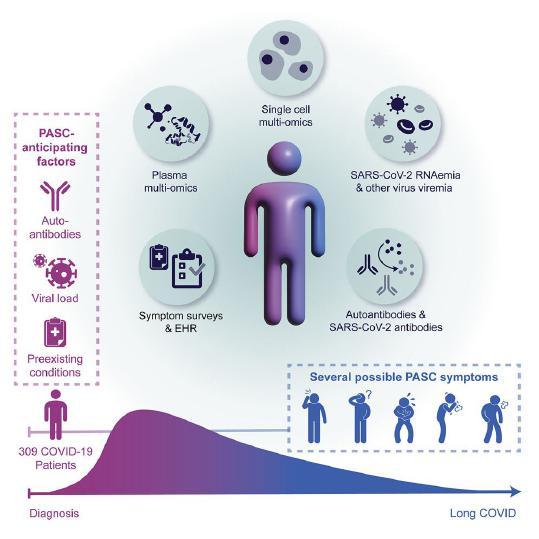
appointment and gives ideas of how a patient can track their condition moving forward
In another major step toward patient support, the U S Department of Health & Human Services recognized Long COVID as a disability in July 2021. A resource page on their website has been devoted to discussing PCC and what these decisions entail In an excerpt from this page, they provide guidance on the topic of PCC as a disability:
“Long COVID can be a disability under the Americans with Disabilities Act (ADA), Section 504, and Section 1557 if it substantially limits one or more major life activities. These laws and their related rules de�ne a person with a disability as an individual with a physical or mental impairment that substantially limits one or more of the major life activities of such individual; a person with a record of such an impairment; or a person who is regarded as having such an impairment A person with long COVID has a disability if the person’s condition or any of its symptoms is a “physical or mental” impairment that “substantially limits” one or more major life activities.”
Persons meeting these requirements are entitled to the same bene�ts and protections as any other person with a disability under the ADA. This is welcome news for patients who have been su�ering through some of the most debilitating symptoms of PCC and have been unable to maintain their quality of life before infection
They continue on, “detectability of most PASC factors at COVID-19 diagnosis emphasizes the importance of early disease measurements for understanding emergent chronic conditions and suggests PASC treatment strategies.” Being able to detect or test for one of these factors would bring healthcare providers a step closer to accurately establishing patient risk and prevalence of PCC
Resources for Patients
Those concerned that they may be experiencing postCOVID-19 Conditions should seek out an appointment with their primary health care provider The CDC has anticipated the questions and concerns new patients face as they approach this subject with their doctors and has provided PDF documents to help facilitate these interactions
• Preparing to Discuss Post-COVID Conditions with a Healthcare Provider
• On the Day of Your Appointment for Post-COVID Conditions
• After a Healthcare Provider Appointment for Post-COVID Conditions
• Healthcare Appointment Checklist for Post-COVID Conditions
These documents are designed to help prepare a patient for their appointment, by organizing their symptoms into a timeline for their provider to assess It also provides questions that should be addressed during this
The road to recovery can be a long one for people su�ering from PCC While many of the associated symptoms can be managed through both pharmacological and non-pharmacological means, patients are encouraged to seek out support groups. It is �tting that the discovery of Long COVID originated from a community of patients online, seeking support and validation for their feelings, and that those support groups still serve that function today.
Linked below are some examples of patient support groups for PCC
•
•
Resources for Providers
In a major step forward, Post-COVID-19 Conditions was given an unspeci�ed ICD-10 code of U09 9 The American Academy of Professional Coders (aacp) clarify its use, stating, “This code enables establishment of a link with COVID-19 This code is not to be used in cases that are still presenting with active COVID-19 However, an exception is made in cases of re-infection with COVID-19, occurring with a condition related to prior COVID-19.” They further clarify that U09 9 is to be used as a secondary code The speci�c condition related to COVID-19 should be coded �rst, and then U09 9 for PCC should be added as a secondary code to link COVID-19.
• Long COVID Alliance
Survivor Corps
Long COVID SOS
FIGURE 2
continued on next page 20 20 21 23 22 24 25 26 27 28 29 23
Reference: Su Y, Yuan D, Chen DG, et al. Multiple early factors anticipate post-acute COVID-19 sequelae Cell 2022; 3;185(5):881-895 e20
CONT.
CONTINUING EDUCATION
PCC is currently treated through the management of symptoms that patients �nd most detrimental to their quality of life The British Medical Journal (BMJ) has provided a document entitled “Management of post-acute COVID-19 in Primary Care.” This document outlines care for PCC and supplies a �ow chart for decision making to better serve patients su�ering from PCC The tool provides suggestions on diagnostic tests, assessments, and both medical and self-management.
Providers are invited to seek out new data on post-COVID19 Conditions as it becomes available There are several trials currently ongoing. Many of these studies are a part of RECOVER (Researching COVID to Enhance Recovery). RECOVER provides resources to both researchers and volunteer participants to join in new studies and become a part of the solution.
Conclusion Statement
The e�ects of COVID-19 are not fully understood and the extent of its impact on human health will be felt for many years. Post-COVID-19 Conditions o�ers a promising example of what can be accomplished when patients support one another and advocate on their behalf Patients were able to shine a light on a condition that a�ects millions of people, and that remained largely unknown within the medical community. Those su�ering from PCC have a long road ahead, with many questions left unanswered, but their e�orts have led directly to the incredible amount of interest and continued research into the topic.
References
1 Centers for Disease Control and Prevention CDC museum COVID-19 timeline https://www cdc gov/museum/timeline/covid19 html#: :text=Januar y%2020%2C%202020,respond%20to%20the%20emerging%20outbr eak (Accessed 2023 Jan 23)
2 Centers for Disease Control and Prevention COVID-19 highlights https://www.cdc.gov/coronavirus/2019-ncov/index.html (Accessed 2023 Jan 23)
3 Centersfor Disease Control and Prevention Symptoms of COVID-19 https://www.cdc.gov/coronavirus/2019-ncov/symptomstesting/symptoms html (Accessed 2023 Jan 23)
4 Tenforde MW, Self WH, Adams K, et al , In�uenza and other viruses in the acutely ill (IVY) network. Association between mRNA vaccination and COVID-19 hospitalization and disease severity JAMA 2021; 326(20):2043-2054
5 Department of Health and Human Services. National research action plan on long COVID https://www covid gov/assets/�les/National-Research-Action-Planon-Long-COVID-08012022 pdf (Accessed 2023 Jan 23)
6 Lambert, N J & Survivor Corps COVID-19 “Long Hauler” Symptoms Survey Report Indiana University School of Medicine; 2020
7 Health News From NPR The coronavirus crisis https://www npr org/sections/healthshots/2020/04/21/838794281/study-raises-questions-about-falsenegatives-from-quick-covid-19-test (Accessed 2023 Jan 25)
8 The White House Memorandum addressing the long-term e�ects of COVID-19 (April 2022) https://www whitehouse gov/brie�ngroom/presidential-actions/2022/04/05/memorandum-onaddressing-the-long-term-e�ects-of-covid-19/ (accessed 2023 Jan 25).
9 COVID gov What is long COVID? https://www covid gov/longcovid/de�nitions (Accessed 2023 Jan 25)
10 United States Food and Drug Administration. At-home COVID-19 antigen tests take steps to reduce your risk of false negative results: FDA safety communication https://www fda gov/medicaldevices/safety-communications/home-covid-19-antigen-tests-takesteps-reduce-your-risk-false-negative-results-fdasafety#:~:text=Molecular%20COVID%2D19%20tests%20are,time%20 when%20someone%20is%20infected (Accessed 2023 Jan 25)
CE ASSESSMENT QUESTIONS
1. Which of the following is the correct description of COVID-19 Conditions (PCC)?
a A family of viruses that can cause respiratory illness in humans.
b Signs, symptoms, and conditions that continue or develop after initial COVID-19 or SARS-CoV-2 infection
c The direct and indirect consequences of the virus SARSCoV-2 on human health.
2. Which of the following is the correct timeframe of COVID-19 Conditions (PCC)’s signs, symptoms, and conditions?
a The signs, symptoms, and conditions may present with a relapsing– remitting pattern and progress or worsen over time.
b The signs, symptoms, and conditions may present within four weeks or less before the initial phase of infection
c The signs, symptoms, and conditions may resolve within four weeks or less after the initial phase of infection.
3. Which of the following are symptoms recognized by the CDC (Centers for Disease Control) as part of an acute COVID-19 infection? [SELECT ALL THAT APPLY]
11 Al-Aly Z, Xie Y, Bowe B High-dimensional characterization of postacute sequelae of COVID-19 Nature 2021;594(7862):259-264
12 Al-Aly Z, Bowe B, Xie Y Long COVID after breakthrough SARS-CoV-2 infection Nat Med 2022; 28(7):1461-1467
13 Centers for Disease Control and Prevention Post-COVID conditions: information for healthcare providers
https://www cdc gov/coronavirus/2019-ncov/hcp/clinical-care/postcovid-conditions.html (Accessed 2023 Jan 25).
14 Centers for Disease Control and Prevention National Center for Health Statistics https://www cdc gov/nchs/covid19/pulse/longcovid.htm (Accessed 2023 Jan 25).
15 Bull-Otterson L, Baca S, Saydah S, et al Post–COVID conditions among adult COVID-19 survivors aged 18–64 and ≥65 years United States, March 2020–November 2021. MMWR Morb Mortal Wkly Rep 2022; 71:713–717
16 National Institute for Health and Care Excellence (2020) COVID-19 rapid guideline: managing the long-term e�ects of COVID-19 (NICE guideline NG188)
https://www nice org uk/guidance/ng188/resources/covid19-rapidguideline-managing-the-longterm-e�ects-of-covid19-pdf51035515742 (Accessed 2023 Jan 30)
17 Ora J, Calzetta L, Frugoni C, Puxeddu E, Rogliani P Expert guidance on the management and challenges of long-COVID syndrome: a systematic review Expert Opin Pharmacother 2023; 1:1-16
18 Bond NG, Grant DS, Himmelfarb ST, et al Post-Ebola syndrome presents with multiple overlapping symptom clusters: evidence from an ongoing cohort study in eastern Sierra Leone Clin Infect Dis 2021; 15;73(6):1046-1054.
19 Advisory Group of the British Society for Immunology Long-term immunological health consequences of COVID-19 (British Society for Immunology, 2020).
20 Su Y, Yuan D, Chen DG, et al Multiple early factors anticipate postacute COVID-19 sequelae Cell 2022; 3;185(5):881-895 e20
21 Centers for Disease Control and Prevention. Preparing to discuss post-COVID conditions with a healthcare provider
a Cough continued on next page 30 31 24
over time
b The signs, symptoms, and conditions may present within four weeks or less before the initial phase of infection
CONT.
c The signs, symptoms, and conditions may resolve within four weeks or less after the initial phase of infection.
https://www nice org uk/guidance/ng188/resources/covid19-rapidguideline-managing-the-longterm-e�ects-of-covid19-pdf51035515742 (Accessed 2023 Jan 30)
17 Ora J, Calzetta L, Frugoni C, Puxeddu E, Rogliani P Expert guidance on the management and challenges of long-COVID syndrome: a systematic review Expert Opin Pharmacother 2023; 1:1-16
3. Which of the following are symptoms recognized by the CDC (Centers for Disease Control) as part of an acute COVID-19 infection? [SELECT ALL THAT APPLY]
a Cough
b Fatigue
c Partial or complete loss of sense of smell
d. Shortness of breath or di�culty breathing
e Swollen lymph nodes
4 Which of the following are correct three early factors that predict post-acute COVID-19 sequelae?
a Asthma,SARS-CoV-2 RN Aemia, varicella-zoster virus viremia
b. Chronicobstructive pulmonary disease, SARS-CoV-2 RN Aemia, varicella-zoster virusviremia
c Type2 diabetes, SARS-CoV-2 RN Aemia, and Epstein-Barr virus viremia
5. Select from the following, the PCC symptoms described by National Institute for Health and Care Excellence (NICE) guideline [NG188] that occur greater than 30%. (SELECT ALL THAT APPY)
a Cognitive impairment
b Dyspnoea
c Fatigue
d. Sleep disturbances
e Smell dysfunction
6 Which of the following is NOT a challenge researchers face in investigation of PCC?
a PCC has yet to be assigned an ICD-10 code
b Scientists have yet to discover the mechanism of pathology behind PCC.
c The di�culty of accurately assessing who has and has not contracted COVID-19
d The reliability issues and mass shortages of COVID-19 tests.
CONTINUING EDUCATION CONTINUING EDUCATION INFORMATION
18 Bond NG, Grant DS, Himmelfarb ST, et al Post-Ebola syndrome presents with multiple overlapping symptom clusters: evidence from an ongoing cohort study in eastern Sierra Leone Clin Infect Dis 2021; 15;73(6):1046-1054
19 Advisory Group of the British Society for Immunology. Long-term immunological health consequences of COVID-19 (British Society for Immunology, 2020)
20 Su Y, Yuan D, Chen DG, et al. Multiple early factors anticipate postacute COVID-19 sequelae Cell 2022; 3;185(5):881-895 e20
21 Centers for Disease Control and Prevention Preparing to discuss post-COVID conditions with a healthcare provider.
https://www cdc gov/coronavirus/2019-ncov/long-term-e�ects/postcovid-appointment/before-appointment pdf (Accessed 2023 Jan 30)
22 Centers for Disease Control and Prevention On the day of your appointment for post-COVID conditions
https://www cdc gov/coronavirus/2019-ncov/long-term-e�ects/postcovid-appointment/during-appointment pdf (Accessed 2023 Jan 30)
23 Centers for Disease Control and Prevention After a healthcare provider appointment for post-COVID conditions
https://www cdc gov/coronavirus/2019-ncov/long-term-e�ects/postcovid-appointment/after-appointment pdf (Accessed 2023 Jan 30)
24 Centers for Disease Control and Prevention. Healthcare appointment checklist for post-COVID conditions
https://www cdc gov/coronavirus/2019-ncov/long-term-e�ects/postcovid-appointment/appointment-checklist.pdf (Accessed 2023 Jan 30)
25 United States Department of Health and Human Services Guidance on “long COVID” as a disability under the ADA, section 504, and section 1557 https://www hhs gov/civil-rights/for-providers/civilrights-covid19/guidance-long-coviddisability/index html#footnote9 62r26tz (Accessed 2023 Feb 2)
26 The Long COVID Alliance https://longcovidalliance org/ (Accessed 2023 Feb 2)
27 Survivor Corps https://www survivorcorps com/ (Accessed 2023 Feb 2)
28 Long COVID SOS https://www longcovidsos org/ (Accessed 2023 Feb 2)
29 The American Academy of Professional Coders ICD-10-CM code for post-COVID condition, unspeci�ed U09 9 https://www aapc com/codes/icd-10-codes/U09
9 (Accessed 2023 Feb 2)
30 Greenhalgh T, Knight M, A’Court C, et al. Management of post acute COVID-19 in primary care BMJ, 2020; 370:m3026
31 RECOVER RECOVER: researching COVID to enhance recovery http://recovercovid org/ (Accessed 2023 Feb 2)
AzPA Members may retrieve FREE CE for this article up to one year after the program release date

This program provides 05 contact hours of continuing education credit.
Accredited Date: 04/07/2023
Expiration Date: 04/07/2026
Universal Activity Number (UAN) is: 0100-0000-23-022-H99-P/T
Apply for credit here: https://www.lecturepanda.com/a/AJPSpring23
TheArizonaPharmacyAssociationisaccreditedbytheAccreditationCouncilforPharmacy Educationasprovidersofcontinuingeducation.
25
Collaborative Practice Agreements and Statewide Protocols
Thisseries,PharmacyandtheLaw,ispresentedbyPharmacistsMutualInsuranceCompanyandtheArizonaPharmacy AssociationthroughPharmacyMarketingGroup,Inc.,acompanydedicatedtoprovidingqualityproductsandservicestothe pharmacycommunity.

Pharmacists are increasingly given options to become more involved in patient care Some of these options result in a pharmacist prescribing or initiating drug therapy While the end result of these activities is very similar, legally, they are quite distinct Collaborative Practice Agreements (CPA) are generally categorized as collaborative prescribing while Statewide Protocols (SP) are classi�ed as autonomous prescribing. Let's explore the distinctions in more detail
A CPA is a formal agreement between a pharmacist and a prescriber under which the pharmacist provides certain patient care functions, such as the initiation, monitoring, modifying, and/or discontinuing of drug therapy. Most states have laws that authorize CPAs. However, there is considerable variation in what practices, and to what extent, are allowed. The CPA must fall within the guidelines dictated by the law authorizing them The CPA should be speci�c about the patient care functions delegated to the pharmacist and the guidelines for the pharmacist's performance of those functions The nature of a CPA limits the pharmacist's intervention only to speci�c patients of the CPA's prescriber.
An SP is di�erent in that it is not limited to a particular pharmacist or particular prescriber. An SP is issued by
a state agency such as the Board of Pharmacy The Board of Pharmacy may act in conjunction with other agencies, including the Board of Health The SP is issued within the guidelines set by the state law or regulation that authorizes SPs The SP authorizes any quali�ed pharmacist to provide the clinical service described in the SP. Most SPs authorize the pharmacist to prescribe and dispense a certain drug or class of drugs to �ll the needs of the class of patients covered by the SP Thus, an SP permits the pharmacist to intervene and provide services to a broader base of patients
The training and education needed by the pharmacist to ful�ll the clinical activities is provided in the law or regulation authorizing the CPA or SP. Any pharmacist wanting to expand the clinical services they o�er should approach the addition of new clinical services methodically What activities are authorized in your state for a CPA or an SP? It makes sense to proceed if your practice has a signi�cant population of patients who could bene�t from these additional services and you have the physical facilities to provide the services These populations might be diabetics, asthmatics, or patients with other medical conditions. Once you have decided on a service to add to your practice, you need to examine whether you are competent and quali�ed to provide that service. If not, you should register for
EDITORIAL
EDITORIAL RX AND THE LAW 26
and obtain the needed training and certi�cation. A pharmacist must comply with the procedures and recordkeeping required by the authorizing law or regulation
As with any new activity, there will be an increase in your liability exposure However, that exposure can be managed through an e�ective risk management program. Analyze the possible risks in advance of implementing the service and incorporate best practices in your procedures to mitigate those risks. A thorough understanding of the requirements and responsibilities under the CPA or SP is essential. Continuous monitoring of the quality of the services rendered is necessary to adjust procedures as situations change Another component of a good risk management program is to have the proper insurance coverage in place Consult with your insurance agent regarding coverage for your new service. No expansion of services is without risk, but e�ective policy and procedures can minimize those risks to a manageable level.
In Our State...
How many pharmacists and physicians can be part of a CPA?
The collaborative practice agreement may be between one or more pharmacists and one or more providers
Is there any restriction on practice setting?
No, pharmacists can work in any practice setting
What providers can enter into a CPA with pharmacists?

Physician who is licensed pursuant to chapter 13 or 17 of this title or a registered nurse practitioner who is licensed pursuant to chapter 15 of this title
Do I have to work in a pharmacy to work under a CPA?
No, in fact many pharmacists are currently providing patient care services as part of telehealth teams, in family practice locations, ambulatory practice clinics etc.
What patient care services can pharmacists perform under a CPA?
Drug therapy and disease management services, including initiating, monitoring, and modifying prescription drug and laboratory test orders that are authorized by the provider and delegated to the pharmacist for the
Keep your eyes and mind open when providing a new service. Research and proper preparation enables you to expand your practice within your risk tolerance bene�ting both you and your patients
© Don R McGuire Jr
R Ph , J D ,
,
is
General Counsel, Senior Vice President, Risk Management & Compliance at Pharmacists Mutual Insurance Company.
This article discusses general principles of law and risk management. It is not intended as legal advice. Pharmacists should consult their own attorneys and insurance companies for speci�c advice Pharmacists should be familiar with policies and procedures of their employers and insurance companies, and act accordingly
purposes of drug therapy management or disease management based on the pharmacist's skills or training.
Are there any restrictions to CPA’s I should be aware of?
Yes one important one is that a provider(s) who enters into a collaborative practice agreement with a pharmacist(s) must have a previously established provider-patient relationship with a patient in order for that patient to be a part of the eligible group of patients who may be included under the CPA. Also, the pharmacist is responsible for maintaining a copy of the CPA and making it available to the board on request Lastly, A pharmacist is responsible for the pharmacist's negligent acts that are the result of the clinical decisions made pursuant to the collaborative practice agreement This subsection does not limit a provider's liability for negligent acts that are not related to a pharmacist's change of medication pursuant to the collaborative practice agreement.
Disclaimer: This does not constitute legal advice consult your legal counsel or risk management before engaging in CPA References • 32-1970
RX
CONT.
AND THE LAW
AzPA is working hard to help increase pharmacist scope of practice. We recently updated the collaborative practice laws in 2022 to modernize the language and intent.
de�nitions
32-1901 De�nitions (79 "Practice of pharmacy"; 87 "Prescription order") 27
Collaborative practice agreements; requirements; rules;
•
Rick G Schnellmann, PhD Dean, University of Arizona College of Pharmacy

SWEHSC Delivers with Collaboration, Research Success

The Southwest Environmental Health Sciences Center has shown a broad reach at the intersection of the environment and human health
Tucked away in the R. Ken Coit College of Pharmacy, the Southwest Environmental Health Sciences Center (SWEHSC) might be one of the best-kept collaboration secrets at the University of Arizona Health Sciences

Founded nearly 30 years ago, SWEHSC (pronounced swee-sic) is part of a national program funded by the National Institute of Environmental Health Sciences and National Institutes of Health to facilitate research on environmental exposures tied to health.
SWEHSC has been led by Nathan Cherrington, PhD, since 2015 The center’s interdisciplinary nature of research and mentorship between new and veteran investigators serves as a career-development service and learning opportunity for both, said Paloma Beamer, PhD, a professor at the Mel and Enid Zuckerman College of Public Health and co-director of SWEHSC’s Community Engagement Core with Ben Richmond, MPH
Many SWEHSC researchers are involved in studies through the BIO5 Institute, UArizona Cancer Center, UArizona Superfund Research Program, UArizona Institute for Resilient Environments and Societies (AIRES), Arizona Department of Environmental Quality and Pima County Health Department.
The center recently helped develop a report and informational webpage for Pima County Health on perand poly�uoroalkyl substances, or PFAS, also known as “forever chemicals ” That PFAS study is connected to ongoing �re�ghter health safety work led by Je�rey Burgess, MD, MS, MPH, a professor in the Zuckerman College of Public Health and co-leader, with Melissa Furlong, PhD, of SWEHSC research on Environmental Exposures in Underserved Southwest Populations.
Dr Beamer also collaborates with Wayne Morgan, MD, and Fernando Martinez, MD, in the UArizona College of Medicine – Tucson’s Department of Pediatrics and UArizona Health Sciences’ Asthma and Airway Disease Research Center, respectively, and Karletta Chief, PhD, in the UArizona College of Agriculture and Life Sciences’ Department of Environmental Science and AIRES’ Indigenous Resilience Center. In each case, SWEHSC helps bring di�erent skillsets to the table to advance the research
For Dr. Chief, it involved ongoing sampling in support of the Gold King Mine Spill Study, for which she and Dr. Beamer were principal investigators, as well as human subjects issues related to another study Dr Chief is doing with the Zuckerman College of Public Health’s Stephanie Russo Carroll, DrPH, MPH, on COVID-19, the Navajo Nation and environmental exposures
Dr. Martinez’ help involved how to get dust samples from homes in Nogales, Sonora, across the U.S.-Mexico border for the Binational Early Asthma and Microbiome Study
“You can’t get more senior than Wayne Morgan, one of the founders of the Tucson Children’s Respiratory Study,” Dr Beamer said “The idea that I’m saying, ‘Because you have a SWEHSC pilot project, Dean Billheimer, PhD, is going to do your statistical analysis’ –this just blew his mind. So, it’s a way for senior investigators to go in new directions in relation to environmental health, which I think is really cool ”
Dr. Billheimer’s roots with SWEHSC go back to 2011. He’s the center’s deputy director and a professor of biostatistics in the Zuckerman College of Public Health He also is co-director of SWEHSC’s Integrative Health Sciences Facility Core and director of its Data Science Resource, two of six facility cores and resources at the center
EDITORIAL
UNIVERSITY
continued on next page 28
Esteban Ramirez, a student from Pima County JTED, a technical education program for high school students, bumps �sts with Nathan Cherrington, PhD (right), director of the Southwest Environmental Health Sciences Center, at a January tour of his lab in the R. Ken Coit College of Pharmacy.
EDITORIAL
& ALUMNI
UNIVERSITY & ALUMNI
“Our core mission is to conduct innovative research and community engagement to understand the mechanisms underlying environmental health risks and disease among people living in semi-arid environments undergoing climate change,” he said.
Those last three words, “undergoing climate change,” were added in the center’s most recent funding renewal in 2022, Dr. Cherrington said, stressing that they are critical to how SWEHSC’s mission has evolved. Whatever climate lessons that can be learned here can be applied to arid areas elsewhere, he hopes “We're sort of an incubator,” he said. “There are 2.2 billion people across the globe who live in arid lands, much like what we have here in the Southwest So much of the world is either in arid lands, or they're going to become so. If you're not going to sink into the ocean, you're likely going to become more like us.”
Dr Billheimer noted Arizona is home to diverse populations, including Latinx, Native American and rural communities, that face unique environmental exposures such as arsenic in some drinking water, high dust and mine waste Ray Hau, PhD, (center) a postdoctoral research fellow, talks to JTED students about strategies using arti�cial intelligence to select new drug therapies that can cross biological barriers.
“We're going to support the communities that live here and are more impacted disproportionately by climate change and the environment,” Dr. Beamer added.
Examples of people who’ve come up in part through SWEHSC include Monica Yellowhair, PhD, the outreach and tribal relations director at the UArizona Cancer Center, and Zelieann Craig, PhD, the College of Agriculture and Life Sciences’ assistant dean for research.

Dr Yellowhair participated in one of SWEHSC’s summer programs as a student, while Dr Craig received pilot and career development funds from SWEHSC She has been a center member since 2013 and now serves on its internal advisory board and career development council and co-director of the IRTH facility core
“SWEHSC is very strong in both population- and labbased discovery research and has established some of the strongest, most important relationships with communities of a variety of backgrounds in the Southwest,” Dr. Craig said. “Nobody else on campus is looking at the intersection of the environment and human health from this many angles ”
Xinxin Ding, PhD, head of the Department of Pharmacology and Toxicology at the Coit College of Pharmacy, chairs SWEHSC’s pilot project program and is director of the Inhalation Exposure Resource He credits the center’s success to Dr. Cherrington’s leadership, saying, “He is the glue that holds everyone together ”
The College of Medicine – Tucson’s Julie Ledford, PhD, who has been involved in SWEHSC research since 2017 and is co-leader with Dr Ding of SWEHSC’s Environmental Lung Diseases Research Focus Group, said, “The numbers speak for themselves.”
In the past decade, the center’s pilot project program invested just under $1 5 million, resulting in almost $58.4 million in total National Institutes of Health awards, including 11 R01 grants, six R21s, two R35s, two P01s, and one each of U54, P42, P50, R03, R56 and K99/R00 awards That’s a total return on investment of 40:1, said Dr Cherrington, who also is the Coit College of Pharmacy’s associate dean for research and head of the Center for Toxicology, which includes pre- and post-doctoral training on environmental toxicology
“Over the last �ve years, UArizona Health Sciences has increased its research expenditures by 58%,” Dr Cherrington added “The 54 center members who are part of the Health Sciences – as most of us are – we’ve increased our research expenditures by 420%. As someone from UArizona Research Administration recently said about us, ‘Have you seen their data? They’re killing it!’”
CONT.
29
Midwestern University College of Pharmacy
Mitchell R. Emerson, PhD Dean, Midwestern University College of Pharmacy
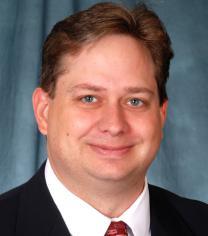
Happy Holidays from the College of Pharmacy at Midwestern University!
Greetings from the College of Pharmacy at Midwestern University. As we welcome spring, we also celebrate the many accomplishments of our students, faculty, and alumni
In early February, the college hosted an evening reception that included engaging continuing education for our alumni and preceptors We also celebrated teaching & learning excellence as our Clinician Educators Program marked the completion of their 10th cohort.
The reception focused on fellowship, networking, and celebrating the challenging but vital work of training and mentoring our current and future colleagues
We had an incredible panel of alumni and preceptors who presented “A Rising Tide Lifts All Boats: Exploring the Journeys of Accomplished Arizona Preceptors ”

The dynamic speakers included:
Asal Azizoddin, PharmD, BCPS
Kevin Kuzma, PharmD, BCOP
CDR Kimberly Langley, PharmD, MBA, BCPS
Christi Jen, PharmD, BCPS, FASHP, FAzPA
Crane Davis, PharmD, FAzPA
Chris Taylor, PharmD, BCPS
The Spring quarter is in full swing, as the Class of 2023 are conducting interviews while counting the days until graduation in May. Many are eagerly awaiting the results of the ASHP Residency Match The Class of 2025 enters their 4th quarter, and the Class of 2024 is leading our SGA and outreach as they look forward to starting rotations in the Fall.
We’re also excited to host APhA in March 2023 in downtown Phoenix with our Alumni and Friends reception. If you’re able to join us on Saturday, March 25 at 5:30pm at the Sheraton Downtown, please reach out to Kimberly at khastings@midwestern edu and look for details in your email

We are looking forward to catching up with all of you and connecting at a future event If you’re ever back in the Glendale area, please reach out and stop by the campus. So much has changed, but still remains the same welcoming place.
If you’ve recently moved or relocated, please ensure we have your updated contact information. Please email updates to your Manager of Alumni Relations, Kimberly Hastings at khastings@midwestern edu
To follow us and learn more about our events and wins, join the MWU Pharmacy social media community:
Like us on Facebook: Midwestern University-College of Pharmacy

Follow us on Twitter: @MWUpharmacy
Follow us on Instagram: @MWUpharmacy
EDITORIAL UNIVERSITY & ALUMNI 30

31
Discount/Cash Cards Are Disruptors in the Industry

On February 25, 2023, PAAS National, had the privilege of participating in a Panel Discussion entitled Marketplace Prescription Dynamics Sure to Shape Your Business Strategies at NCPA Multiple Locations Conference. While traversing several di�erent topic areas, one of the core issues important to community pharmacies is discount/cash cards.
IQVIA published a white paper entitled Pharmacy Discount Card Utilization and Impact in August of 2022 with several interesting �ndings Among them, discount card utilization has grown to 5 4% of all pharmacy adjudications in 2021, a 63% increase over 2017 - of which “Not So GoodRx” now represents 46%. Only 9% of discount card transactions are for branded products. For Medicare patients, nearly 1 in 5 (19%) used a discount card. Commercial patients were 12%, but that doubled to 24% for those with an observed deductible Cash paying patients represented 56% of all patients, and 52% of transactions
While the discount card growth has been remarkable, what makes them disruptors in the industry has been their impact on the traditional PBM model. Discount cards have been e�ective at undermining the perceived bene�t that PBMs are supposed to provide (i e , why is GoodRx able to o�er a better price on my prescriptions than my insurance) Additionally, patients’ out of pocket costs are typically not captured when they use discount cards unless a patient is going to submit claims on their own (in addition to gaps in adherence metrics and other quality measures). In response, Express Scripts announced a partnership
with GoodRx to include a “lesser of” logic when processing prescription claims through their Price Assure program Not to be outdone, OptumRx launched Price Edge which will review direct-toconsumer prescription drug prices and o�er members the lowest available price. Comically, OptumRx said they currently o�er the best price to their members about 90% of the time, meaning 10% of the time patients are getting a raw deal Both of these programs are automatically including these drug purchases into member’s deductibles going forward
Pharmacies know that discount cards are really just another form of spread pricing, bene�ting the discount card provider and PBM. GoodRx reports that it earns 15% of the patient’s total retail prescription cost, and that doesn’t include a fee for the PBM processor. Interestingly, GoodRx had disclosed that Kroger had accounted for only 5% of participating pharmacies, but nearly 25% of prescription transaction revenue How could it have been that high? As a chain, Kroger was more likely dutiful in their utilization and/or promotion of GoodRx for patients. Most independents despise GoodRx and will create work arounds to avoid utilizing the card (e.g., with aggressive cash pricing or pricematching). Pharmacies should always be careful not to jeopardize their usual and customary With the integration from these new programs by the PBMs, bypassing discount cards will likely no longer be an option for insured patients The impact on BER, GER and even DIR fees for 2023, and beyond, are not clear
EDITORIAL
EDITORIAL PAAS NATIONAL continued on next page 1 2 3 4 32
Speaking of jeopardizing your Usual & Customary pricing, Amazon’s RxPass should be a �op If you haven’t heard or read about it, Amazon is o�ering their Prime members “eligible medications for one �at, low monthly fee of $5, and have them delivered free of charge”. Patients with Medicare, Medicaid, or located in one of the seven states they exclude are not eligible to participate The broader question is how long it will take the DOJ and HHS-OIG to enforce the U&C issue that has already played out with Walgreens (and many others) PAAS previously illuminated the $60 million settlement with the Prescription Savings Club in the March 2019 PAAS Newsline: AVOID “Discount Clubs” for Cash Patients. That same DOJ announcement also discussed the infamous Insulin Pen Box Settlement for $200 million. Amazon clearly missed this settlement, as the PillPack subsidiary paid a $5 79 million settlement in May 2022 for the same insulin pen dispensing practices
PAAS National® is committed to serving community pharmacies and helping keep hard-earned money where it belongs. Contact PAAS today at (608) 873-1342 or info@paasnational.com to see why PAAS Audit Assistance membership might be right for you.
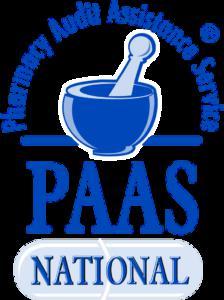
References
1 https://www iqvia com/locations/united-states/library/whitepapers/pharmacy-discount-card-utilization-and-impact
2. https://www.evernorth.com/articles/increased-pharmacysavings-and-a�ordable-prescription-medication
3 https://www optum com/about-us/news/page hub optumrxprice-edge-for-best-prescription-price html
4 https://www drugchannels net/2022/05/the-goodrx-krogerblowup-spread-pricing html
5 https://pharmacy amazon com/rxpass
6 https://portal paasnational com/Paas/Newsletter/Go/553
7 https://www.justice.gov/usao-sdny/pr/manhattan-us-attorneyannounces-2692-million-recovery-walgreens-two-civilhealthcare
8 https://www justice gov/usao-sdny/pr/us-attorney-announcessettlement-fraud-lawsuit-against-online-pharmacyoverdispensing
By Trenton Thiede, PharmD, MBA, President at PAAS National , expert third party audit Assistance

®
and FWA/HIPAA
compliance.
Copyright © 2023 PAAS National, LLC Unauthorized use or distribution prohibited. All use subject to terms at https://paasnational.com/terms-of-use/.
EDITORIAL
CONT. PAAS NATIONAL 5 6 7 8 33
AzPA Legislative Update
BillStatusupdatedthroughApril14,2023.Tocheckonthestatusofthesebillsorothersvisit: https://apps.azleg.gov/BillStatus/BillOverview?SessionID=127
HIGH PRIORITY
Bill Number HB2207
Bill Title Insurance; reimbursement rates; pharmacists
Primary Sponsor Rep Justin Wilmeth (R)
Summary Health and disability insurers that issue, amend, deliver, or renew a subscription contract, policy, or evidence of coverage after the e�ective date of this legislation are required to provide reimbursement coverage to a pharmacist at a rate not less than the rate provide to a licensed physician, nurse practitioner, or physician assistant. In order for the service or procedure to be covered, the pharmacist is required to act within the scope of practice and the service or procedure must otherwise be covered under the policy
Comment Az Pharmacy Association bill We chose to hold this bill to continue the discussions with BCBS and the other insurers.
Last Action/Final Disposition DEAD
Bill Number SB1248
Bill Title Scope of practice; process; repeal
Primary Sponsor Sen Thomas "T J " Shope (R)
Summary Statute establishing a process for a health professional group seeking an increased scope of practice would have been repealed AS VETOED BY GOVERNOR. In her veto letter, the Governor expresses concern about doing away with the sunrise process altogether, but says she is committed to identifying alternative pathways toward scope of practice expansion
Comment Priority bill that eliminates the �ling of scope of practice expansion applications Still have the legislative process for the actual scope of practice expansion bill
Last Action/Final Disposition VETOED on 3/3/23.
Bill Number SB1382
Bill Title Pharmacy bene�t managers; certi�cate requirements
Primary Sponsor Sen Janae Shamp (R)
Summary Pharmacy bene�t managers are required to obtain a valid certi�cate of authority to operate as a pharmacy bene�t manager in Arizona from the Department of Insurance and Financial Institutions (DIFI). Information that must be included in an application for a certi�cate of authority is speci�ed.
DIFI is authorized to issue a cease and desist order if a pharmacy bene�t manager does not hold a valid certi�cate, and is authorized to suspend or revoke a certi�cate in speci�ed circumstances. Establishes civil penalties for violations DIFI is required to establish a record retention schedule for all data related to enforcement of these requirements E�ective January 1, 2025
Comment This is a priority bill of the Az Independent Pharmacy Coalition.
Last Action/Final Disposition Signed by Governor.
Bill Number SB1254
Bill Title Opioids; containers; labeling; requirements; repeal
Primary Sponsor Sen Janae Shamp (R)
Summary Deletes the requirement for the container of a schedule II controlled substance that is an opioid that is directly dispensed by a pharmacist and that is not for the immediate administration to the ultimate user to have a red cap.
Last Action/Final Disposition Passed House Rules committee on 3/20/23. Awaiting House COW.
Bill Number HB2608
Bill Title Pharmacists; prescriptions orders; requirements
Primary Sponsor Rep Keith Seaman (D)
Summary If a person presents a valid prescription order to a pharmacist and the pharmacy has the prescription medication in stock, the pharmacist is required to �ll the prescription order. if the pharmacy does not have the prescription medication in stock, the pharmacist is required to return the prescription order to the person who presented the prescription order or the patient or, on request, must electronically transfer the prescription order to a pharmacy that is able to �ll the prescription order.
Last Action/Final Disposition Held in committees –DEAD!
ADVOCACY LEGISATIVE UPDATE
34
CONT.
LEGISATIVE UPDATE
MEDIUM PRIORITY
Bill Number HB2254
Bill Title Rulemaking; regulatory costs; legislative rati�cation
Primary Sponsor Rep Justin Wilmeth (R)
Summary If a proposed rule is estimated to increase regulatory costs in Arizona in excess of $500,000 within two years after implementation or to have an adverse impact on economic growth in Arizona in excess of $500,000 within two years after implementation, the proposed rule cannot become e�ective until the Legislature enacts legislation ratifying the proposed rule The agency is prohibited from �ling a �nal rule with the Secretary of State before obtaining legislative approval of the rule through legislation
Comment Tech Counci member comment "lt seems like a blanket power grab by the legislature to try and weaken the reach of the executive branch or ACC. It nulli�es any rule that "has an adverse impact on economic growth." That is really broad. - Monitoring. Senate GOV amendment increased the bill's two year timeframe to �ve years.
Last Action/Final Disposition Passed House and Senate-Will be sent to Governor
Bill Number HB2344
Bill Title Pharmacy board; duties; regulation
Primary Sponsor Rep. Amish Shah (D)
Summary Various changes to statutes relating to the Board of Pharmacy. The list of prohibited acts is expanded to include wholesaling or distributing a prescription drug or device, a controlled substance, a nonprescription drug, medical gas or durable medical equipment without a valid Board-issued permit, and in the case of a manufacturer, manufacturing, possessing or shipping into Arizona a manufactured prescription drug or device, a controlled substance, a nonprescription drug, a precursor chemical or any other regulated chemical without a valid Board-issued permit. Board permittees are required to notify the Board within 15 days of various information changes, including a change to hours of operation The list of acts constituting unprofessional conduct for Board permittees is expanded to include failing to routinely operate according to the permittee's hours of operation and failing to report an unexpected serious adverse drug event from a compounded prescription
that resulted in a patient being hospitalized or that resulted in death and that meets other speci�ed conditions. The Board is authorized to delegate to the Executive Director the authority to issue a subpoena to solicit information about a complaint or investigation and the authority to enter into agreements between a state or federal regulatory agency
Comment Az Bd of Pharmacy bill We have concerns with some of the provisions of the bill
Last Action/Final Disposition Held in committeesDEAD
Bill Number SB1087
Bill Title Professional licensure fees; waiver; reduction
Primary Sponsor Sen Anthony Kern (R)
Summary By September 1 of each year, each regulatory board and agency is required to review the costs it incurs, the monies it has in its funds, and the fee revenues it collects to determine whether the regulatory board or agency expects ending balances in its licensing fund to exceed 50 percent of the appropriations from that fund in the current �scal year. If the regulatory board or agency determines that the ending balance in its licensing fund would exceed 50 percent of its appropriation, the regulatory board or agency is required to provide a onetime waiver or reduction from licensure or certi�cation renewal fees to reduce the balance in its licensing fund to below 50 percent of its appropriation from that fund in the upcoming �scal year, or within the board's or agency's normal schedule for renewing licenses or certi�cates if longer than one year.
Last Action/Final Disposition Passed (DP) House RA committee on 3/15/23 Awaiting House Rules committee
35
CONT. LEGISATIVE UPDATE
LOWER PRIORITY
Bill Number HB2001

Bill Title Department of health services; rulemaking
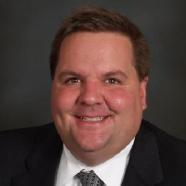

Primary Sponsor Rep David L Cook (R)
Summary The Administrative Procedures Act does not apply to rules made by the Department of Health Services to regulate an accredited hospital if the rules reduce a regulatory burden without jeopardizing health and safety, do not increase costs to regulated persons, and the public is given at least 15 days to comment on the rules prior to their adoption. Emergency clause.
Comment 1/23: Montenegro will amend to allow for hospitals Senate HHS amended the bill to prohibit ADHS rules regarding radiation oncology services to exceed CMS regs in the areas of direct physician supervision, technician sta�ng requirements and training or experience requirements ADHS has big problems with the bill now.

Last Action/Final Disposition Passed (DPA) Senate HHS on 3/28/23. Awaiting Senate Rules Committee.
Bill Number HB2564
Bill Title Hospitals; physicians; dispensing opioids
Primary Sponsor Rep Amish Shah (D)
Summary A hospital or a "health professional" (de�ned) who is working in a hospital that is not within 50 miles of a 24- hour pharmacy, when discharging a patient with an acute illness or injury after regular pharmacy business hours, is allowed to dispense a 12hour supply of a schedule II controlled substance that is an opioid to the patient.
Last Action/Final Disposition Signed by Governor.
YOUR TEAM
Dianne McCallister AzPA Lobbyist
Kelly Fine AzPA CEO
Ken Bykowski AzPA Legislative A�airs Committee Co-Chair
36
Mark Boesen AzPA Legislative A�airs Committee Co-Chair
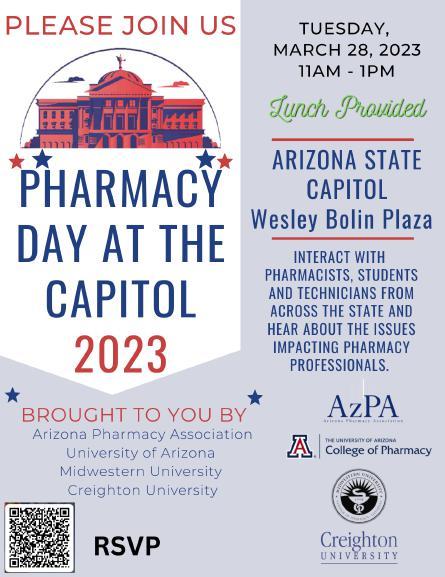

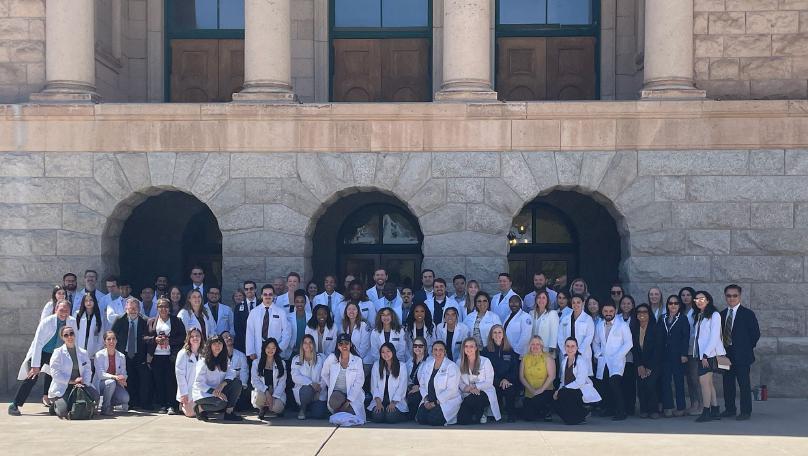

T U E S D A Y , M A R C H 2 8 , 2 0 2 3 PHARMACY DAY AT THE CAPITOL Over 150 pharmacists, pharmacy technicians and student pharmacists from University of Arizona, Midwestern University, and Creighton University �lled our state’s capital with white coats to promote our profession. We engaged with over 50 legislators, and their sta�. PharmacyProfessionalsUNITEtoPaintItWhite! 37
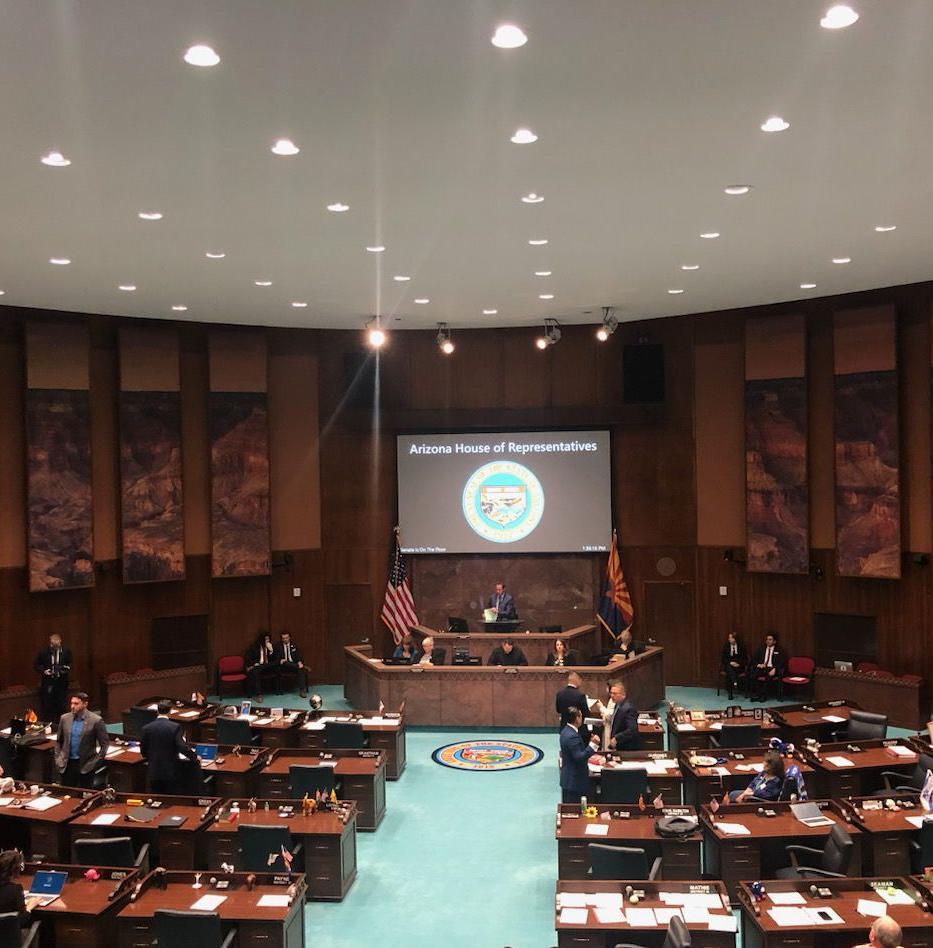

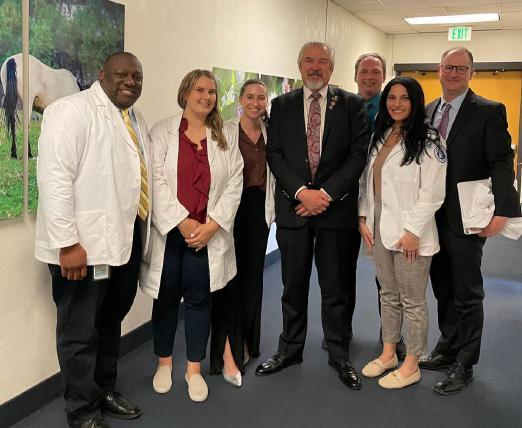
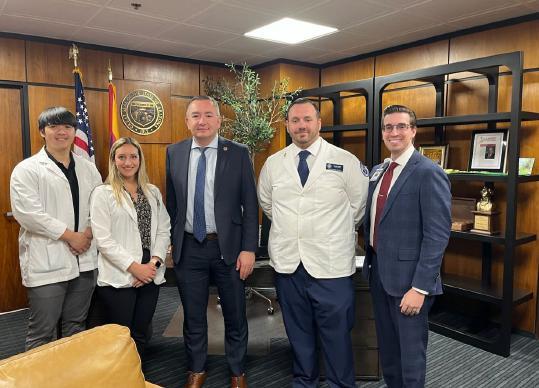
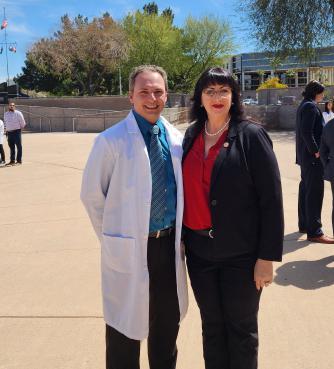
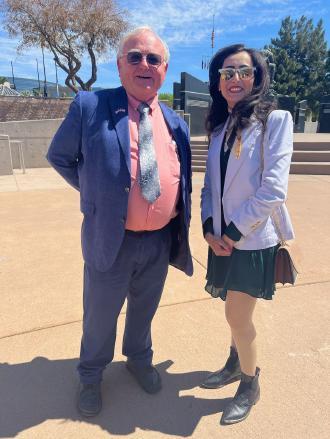
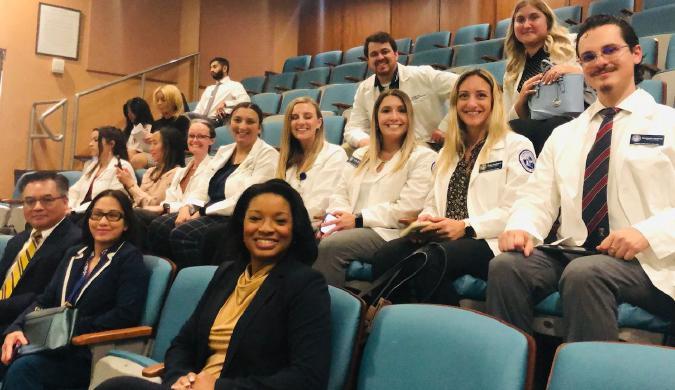

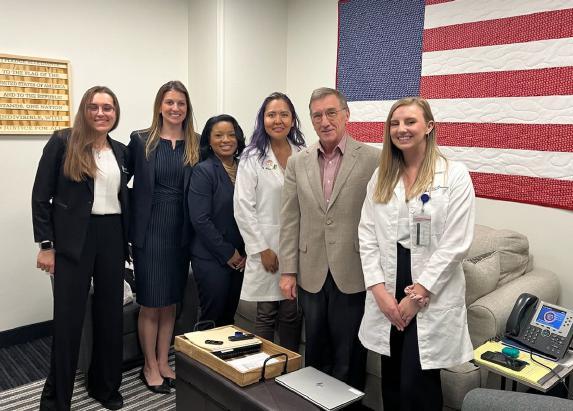
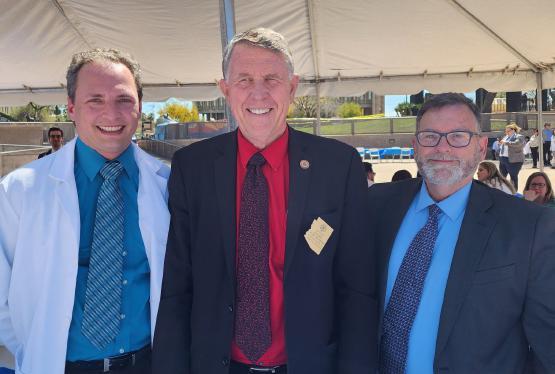
38
Arizona State Board of Pharmacy Update

Mailing Address: P.O. Box 18520 Phoenix, AZ 85005
BOARD MEMBERS
34.A.iv Discussion, Consideration and Possible
Action: Hospital Site Pharmacy Summary – The board discussed the new law that was passed in 2022 and rescinded prior discussions regarding restricting the number of locations and restricting compounding The Board decided it cannot put a limit on the number of sites due to it con�icting with Az statutes and also decided that compounding would be permissible in the remote hospital locations so long as they followed the same procedures as the main hospital.
34.A.v Discussion, Consideration and Possible
UPDATES DISCUSSED AT THE APRIL 5-6, 2023 BOARD MEETING
34. Reports - Discussion, Determination and Possible Action
34.A Executive Director Report
34.A.i Discussion, Consideration and Possible Action: Adopting the O�cial compendium with speci�c focus on USP 795, 797, 800 - The USP <795> and <797> chapters were published on November 1, 2022, but do not take e�ect until November 1, 2023, due to a 1-year implementation period In addition, USP <800>, the hazardous drug compounding and safe handling standards will also become o�cial on that same date. Since Arizona statutes o�cially adopt the USP Compendium the Board may begin enforcement starting in November.
34.A.ii Discussion, Consideration and Possible Action: Substance Use Programs Meeting to Discuss Improved Transparency and Alignment to Meet the Board's Mission - The �rst meeting with the 2 contracted programs went well and Board sta� will continue to work with programs to improve communication and procedures.
th
Action: Remote working in Another State for a Resident permit – Concerns were raised regarding pharmacists licensed in AZ who also provide services to patients in other states and what procedures were in place to identify that they are complying with laws based on the state the patient resides in Some members felt it was the responsibility of business. The Board decided to bring this concern up at the next Rules Task Force meeting in May.
34.A.vi Discussion, Consideration and Possible
Action: Arizona Poison and Drug Information Center - Presentation on impact and service to community
34.A.vii Discussion, Consideration and Possible Action: Request to pursue Emergency Rules for Technician Immunization - Board approved moving forward on an emergency rule package due to uncertainty of termination of the PHE in May.
34.A.viii Discussion, Consideration and Possible
Action: Update of Board Requested Items – The Board has established a just culture task force which will have its �rst meeting in May
34 B Deputy Director Report
34.B.i Discussion, Consideration and Possible
Action: Live Versus Virtual Attendance Expectations at Board Meetings - It was decided that Board meeting attendance can continue to be in person or virtual; however, there is a preference for in person
EDITORIAL L o r r i W a l m s l e y R P h , P r e s i d e n t T e n i l l e D a v i s , P h a r m D , V i c e P r e s i d e n t C e d a r L a h a n n , P h a r m D , R P h , M e m b e r T h e o d o r e T o n g , P h a r m D , R P h , M e m b e r K e v i n D a n g , P h a r m D , R P h , M e m b e r K r i s t e n S n a i r , C P h T , M e m b e r J o s e p h L e y b a , R P h , M e m b e r F r a n k T h o r w a l d , M e m b e r ( P u b l i c )
W. Washington St., Suite 260, Phoenix, AZ 85007
PHARMACY
Physical Address: 1110
ADVOCACY BOARD OF
34.A.iii Discussion, Consideration and Possible Action: COVID-19 Public Health Emergency Transition Roadmap - The national Public Health Emergency is set to expire on May 12 There is still uncertainty regarding Prep Act authorities and whether these will remain in e�ect or be modi�ed once the PHE ends continued on next page 39
EDITORIAL CONT. ADVOCACY
• 34.B.ii Discussion, Consideration and Possible Action: Board Member Request to Discuss
O�ering CE for Attendance at Public Board
Meetings - Board sta� will research options of o�ering CE for attending a Board meeting
• 34.B.iii 2023 Compliance Team Activity Report
• 34.B.iv 2023 Licensing Team Activity Report
34.B.v Board Sta� Updates – Board is hiring 2 more compliance o�cers and an administrative assistant
34.C CSPMP Director Report
• 34.C.i Review of Arizona PMP Data - 2017-2022
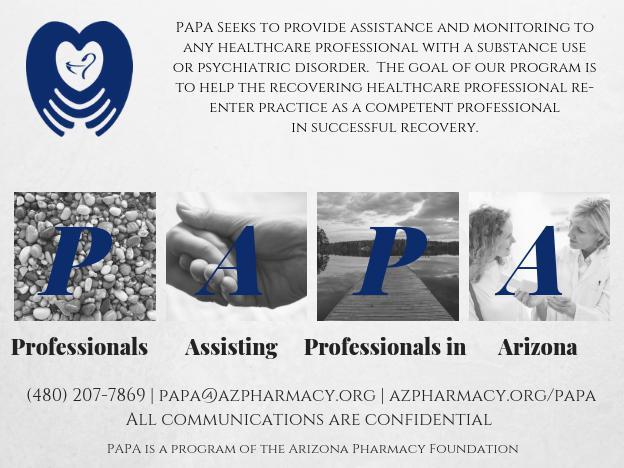
34 C ii OTC Naloxone - Impact on CSPMP Reporting
34.C.iii Xylazine Concerns
Note: This article is prepared by AZPA The information contained in this article does not express the opinions of AZPA or ASBP and are provided as a resource only Please verify all information through your normal procedures
UPCOMING MEETINGS
MEETING DATE Task Force Committee-Rule Writing April 19, 2023 9:00 AM Oral Proceeding/Public comment: Prescribing a Self-Administered Hormonal Contraceptive May 16, 2023 9:00 AM Task Force Committee-Rule Writing May 24, 2023 9:00 AM Complaint Review June 6, 2023 1:00 PM Board Meeting June 14-15, 2023 8:30 AM
40

41


































































